Assignment on Brand Management (HNC5)
VerifiedAdded on 2021/02/20
|24
|6685
|25
AI Summary
Contribute Materials
Your contribution can guide someone’s learning journey. Share your
documents today.
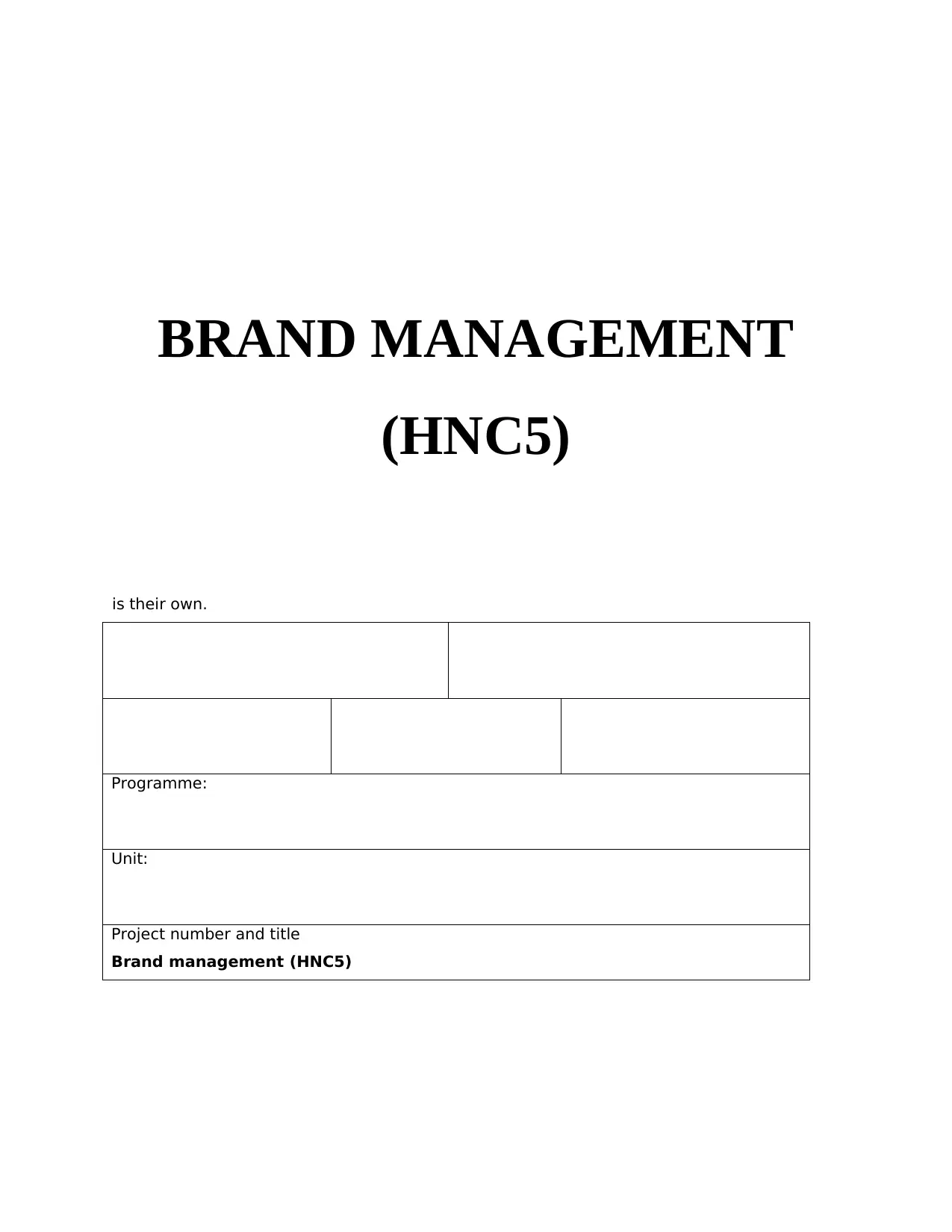
BRAND MANAGEMENT
(HNC5)
is their own.
Programme:
Unit:
Project number and title
Brand management (HNC5)
(HNC5)
is their own.
Programme:
Unit:
Project number and title
Brand management (HNC5)
Secure Best Marks with AI Grader
Need help grading? Try our AI Grader for instant feedback on your assignments.


Table of Contents
INTRODUCTION...........................................................................................................................1
MAIN BODY...................................................................................................................................1
LO1..................................................................................................................................................1
P1 Meaning of Branding........................................................................................................1
P2 Brand equity......................................................................................................................1
P3 Brand Hierarchy and portfolio Management....................................................................2
Building Brands......................................................................................................................4
Managing a Brand over time..................................................................................................6
LO2..................................................................................................................................................7
Brand portfolio Strategy.........................................................................................................7
Brand hierarchy......................................................................................................................8
CONCLUSION................................................................................................................................9
REFERENCES..............................................................................................................................10
INTRODCTION..............................................................................................................................1
TASK 3............................................................................................................................................1
P4 Evaluation on management of brand at domestic and global level...................................1
TASK 4............................................................................................................................................3
P5 techniques for measuring and managing brand value.......................................................3
CONCLUSION................................................................................................................................6
REFRENCES...................................................................................................................................1
INTRODUCTION...........................................................................................................................1
MAIN BODY...................................................................................................................................1
LO1..................................................................................................................................................1
P1 Meaning of Branding........................................................................................................1
P2 Brand equity......................................................................................................................1
P3 Brand Hierarchy and portfolio Management....................................................................2
Building Brands......................................................................................................................4
Managing a Brand over time..................................................................................................6
LO2..................................................................................................................................................7
Brand portfolio Strategy.........................................................................................................7
Brand hierarchy......................................................................................................................8
CONCLUSION................................................................................................................................9
REFERENCES..............................................................................................................................10
INTRODCTION..............................................................................................................................1
TASK 3............................................................................................................................................1
P4 Evaluation on management of brand at domestic and global level...................................1
TASK 4............................................................................................................................................3
P5 techniques for measuring and managing brand value.......................................................3
CONCLUSION................................................................................................................................6
REFRENCES...................................................................................................................................1

Secure Best Marks with AI Grader
Need help grading? Try our AI Grader for instant feedback on your assignments.
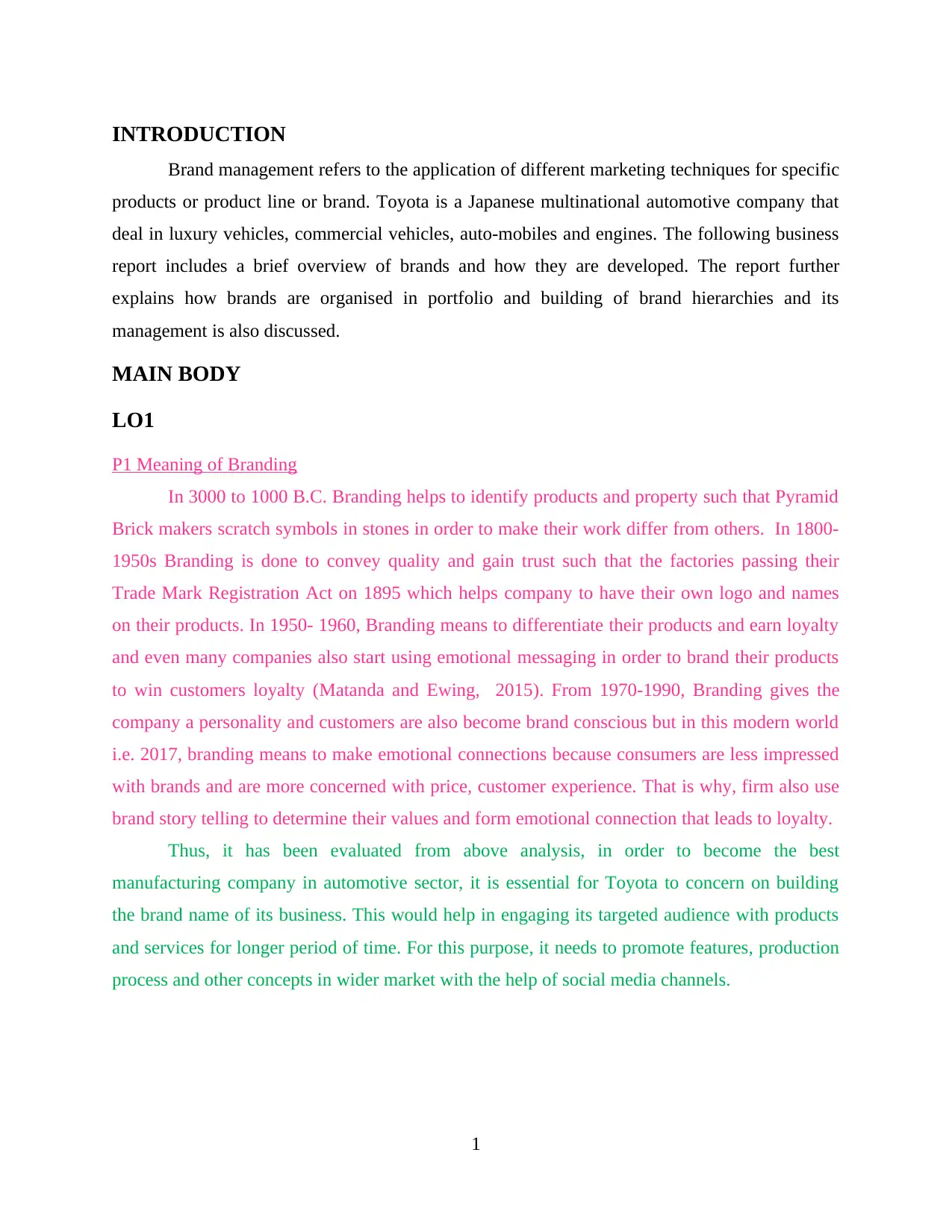
INTRODUCTION
Brand management refers to the application of different marketing techniques for specific
products or product line or brand. Toyota is a Japanese multinational automotive company that
deal in luxury vehicles, commercial vehicles, auto-mobiles and engines. The following business
report includes a brief overview of brands and how they are developed. The report further
explains how brands are organised in portfolio and building of brand hierarchies and its
management is also discussed.
MAIN BODY
LO1
P1 Meaning of Branding
In 3000 to 1000 B.C. Branding helps to identify products and property such that Pyramid
Brick makers scratch symbols in stones in order to make their work differ from others. In 1800-
1950s Branding is done to convey quality and gain trust such that the factories passing their
Trade Mark Registration Act on 1895 which helps company to have their own logo and names
on their products. In 1950- 1960, Branding means to differentiate their products and earn loyalty
and even many companies also start using emotional messaging in order to brand their products
to win customers loyalty (Matanda and Ewing, 2015). From 1970-1990, Branding gives the
company a personality and customers are also become brand conscious but in this modern world
i.e. 2017, branding means to make emotional connections because consumers are less impressed
with brands and are more concerned with price, customer experience. That is why, firm also use
brand story telling to determine their values and form emotional connection that leads to loyalty.
Thus, it has been evaluated from above analysis, in order to become the best
manufacturing company in automotive sector, it is essential for Toyota to concern on building
the brand name of its business. This would help in engaging its targeted audience with products
and services for longer period of time. For this purpose, it needs to promote features, production
process and other concepts in wider market with the help of social media channels.
1
Brand management refers to the application of different marketing techniques for specific
products or product line or brand. Toyota is a Japanese multinational automotive company that
deal in luxury vehicles, commercial vehicles, auto-mobiles and engines. The following business
report includes a brief overview of brands and how they are developed. The report further
explains how brands are organised in portfolio and building of brand hierarchies and its
management is also discussed.
MAIN BODY
LO1
P1 Meaning of Branding
In 3000 to 1000 B.C. Branding helps to identify products and property such that Pyramid
Brick makers scratch symbols in stones in order to make their work differ from others. In 1800-
1950s Branding is done to convey quality and gain trust such that the factories passing their
Trade Mark Registration Act on 1895 which helps company to have their own logo and names
on their products. In 1950- 1960, Branding means to differentiate their products and earn loyalty
and even many companies also start using emotional messaging in order to brand their products
to win customers loyalty (Matanda and Ewing, 2015). From 1970-1990, Branding gives the
company a personality and customers are also become brand conscious but in this modern world
i.e. 2017, branding means to make emotional connections because consumers are less impressed
with brands and are more concerned with price, customer experience. That is why, firm also use
brand story telling to determine their values and form emotional connection that leads to loyalty.
Thus, it has been evaluated from above analysis, in order to become the best
manufacturing company in automotive sector, it is essential for Toyota to concern on building
the brand name of its business. This would help in engaging its targeted audience with products
and services for longer period of time. For this purpose, it needs to promote features, production
process and other concepts in wider market with the help of social media channels.
1
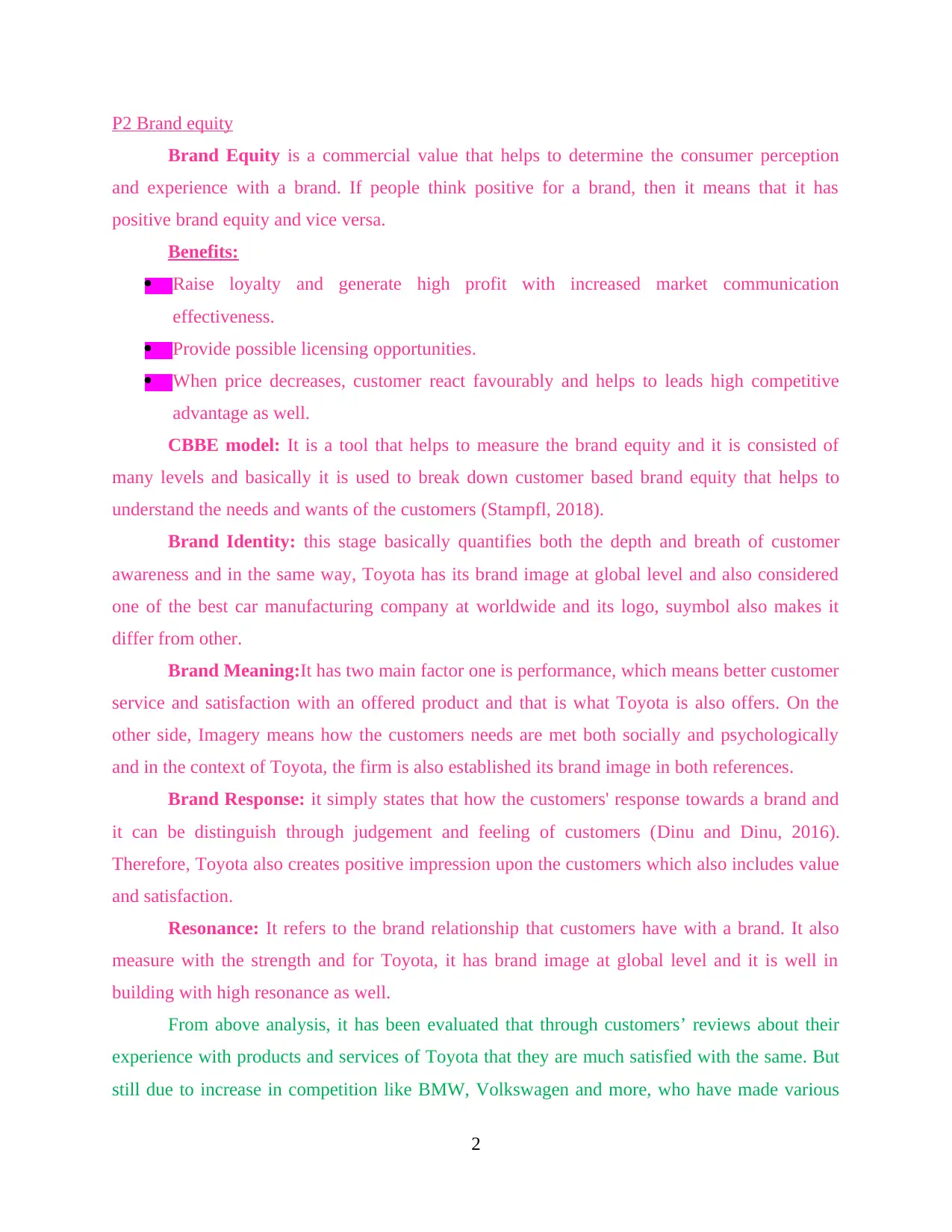
P2 Brand equity
Brand Equity is a commercial value that helps to determine the consumer perception
and experience with a brand. If people think positive for a brand, then it means that it has
positive brand equity and vice versa.
Benefits:
Raise loyalty and generate high profit with increased market communication
effectiveness.
Provide possible licensing opportunities.
When price decreases, customer react favourably and helps to leads high competitive
advantage as well.
CBBE model: It is a tool that helps to measure the brand equity and it is consisted of
many levels and basically it is used to break down customer based brand equity that helps to
understand the needs and wants of the customers (Stampfl, 2018).
Brand Identity: this stage basically quantifies both the depth and breath of customer
awareness and in the same way, Toyota has its brand image at global level and also considered
one of the best car manufacturing company at worldwide and its logo, suymbol also makes it
differ from other.
Brand Meaning:It has two main factor one is performance, which means better customer
service and satisfaction with an offered product and that is what Toyota is also offers. On the
other side, Imagery means how the customers needs are met both socially and psychologically
and in the context of Toyota, the firm is also established its brand image in both references.
Brand Response: it simply states that how the customers' response towards a brand and
it can be distinguish through judgement and feeling of customers (Dinu and Dinu, 2016).
Therefore, Toyota also creates positive impression upon the customers which also includes value
and satisfaction.
Resonance: It refers to the brand relationship that customers have with a brand. It also
measure with the strength and for Toyota, it has brand image at global level and it is well in
building with high resonance as well.
From above analysis, it has been evaluated that through customers’ reviews about their
experience with products and services of Toyota that they are much satisfied with the same. But
still due to increase in competition like BMW, Volkswagen and more, who have made various
2
Brand Equity is a commercial value that helps to determine the consumer perception
and experience with a brand. If people think positive for a brand, then it means that it has
positive brand equity and vice versa.
Benefits:
Raise loyalty and generate high profit with increased market communication
effectiveness.
Provide possible licensing opportunities.
When price decreases, customer react favourably and helps to leads high competitive
advantage as well.
CBBE model: It is a tool that helps to measure the brand equity and it is consisted of
many levels and basically it is used to break down customer based brand equity that helps to
understand the needs and wants of the customers (Stampfl, 2018).
Brand Identity: this stage basically quantifies both the depth and breath of customer
awareness and in the same way, Toyota has its brand image at global level and also considered
one of the best car manufacturing company at worldwide and its logo, suymbol also makes it
differ from other.
Brand Meaning:It has two main factor one is performance, which means better customer
service and satisfaction with an offered product and that is what Toyota is also offers. On the
other side, Imagery means how the customers needs are met both socially and psychologically
and in the context of Toyota, the firm is also established its brand image in both references.
Brand Response: it simply states that how the customers' response towards a brand and
it can be distinguish through judgement and feeling of customers (Dinu and Dinu, 2016).
Therefore, Toyota also creates positive impression upon the customers which also includes value
and satisfaction.
Resonance: It refers to the brand relationship that customers have with a brand. It also
measure with the strength and for Toyota, it has brand image at global level and it is well in
building with high resonance as well.
From above analysis, it has been evaluated that through customers’ reviews about their
experience with products and services of Toyota that they are much satisfied with the same. But
still due to increase in competition like BMW, Volkswagen and more, who have made various
2
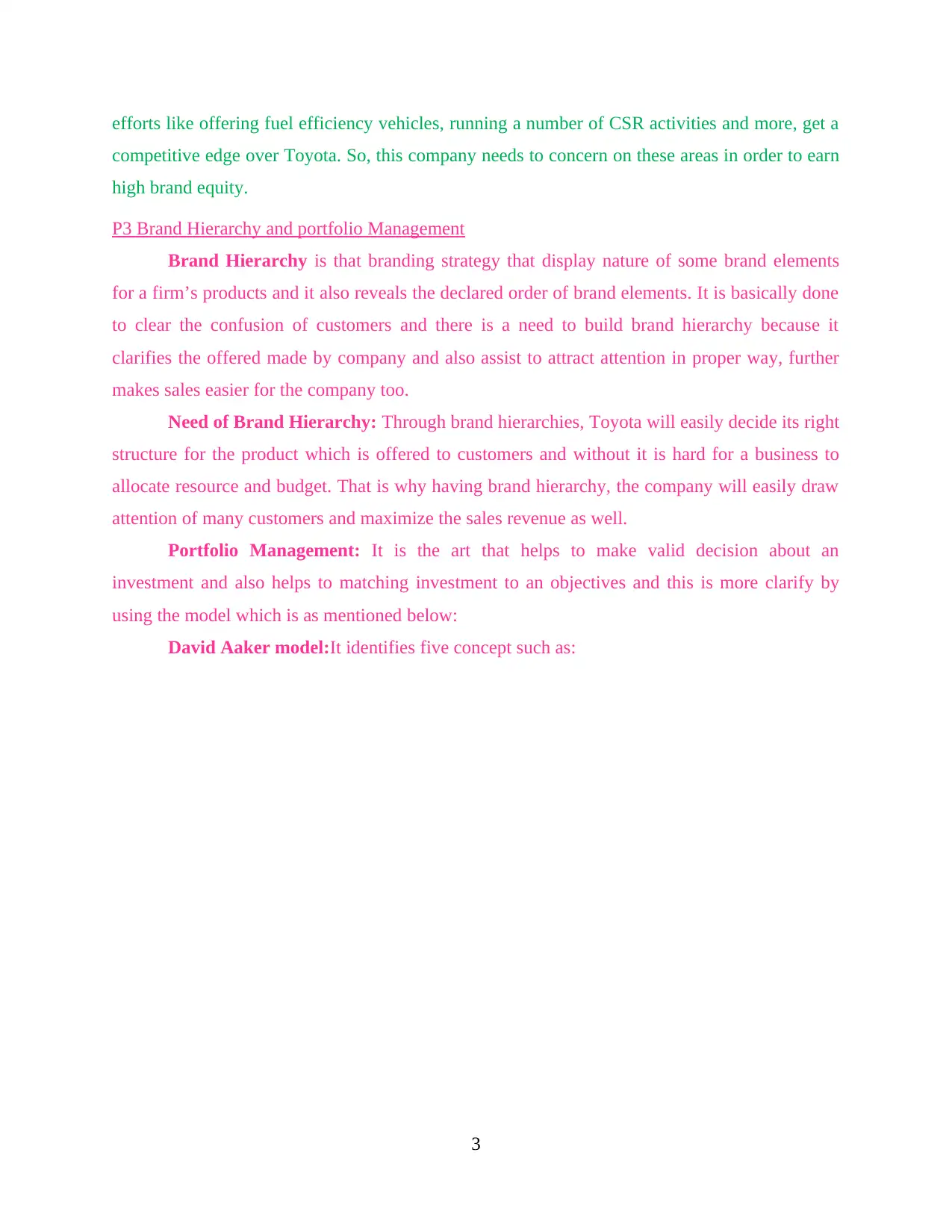
efforts like offering fuel efficiency vehicles, running a number of CSR activities and more, get a
competitive edge over Toyota. So, this company needs to concern on these areas in order to earn
high brand equity.
P3 Brand Hierarchy and portfolio Management
Brand Hierarchy is that branding strategy that display nature of some brand elements
for a firm’s products and it also reveals the declared order of brand elements. It is basically done
to clear the confusion of customers and there is a need to build brand hierarchy because it
clarifies the offered made by company and also assist to attract attention in proper way, further
makes sales easier for the company too.
Need of Brand Hierarchy: Through brand hierarchies, Toyota will easily decide its right
structure for the product which is offered to customers and without it is hard for a business to
allocate resource and budget. That is why having brand hierarchy, the company will easily draw
attention of many customers and maximize the sales revenue as well.
Portfolio Management: It is the art that helps to make valid decision about an
investment and also helps to matching investment to an objectives and this is more clarify by
using the model which is as mentioned below:
David Aaker model:It identifies five concept such as:
3
competitive edge over Toyota. So, this company needs to concern on these areas in order to earn
high brand equity.
P3 Brand Hierarchy and portfolio Management
Brand Hierarchy is that branding strategy that display nature of some brand elements
for a firm’s products and it also reveals the declared order of brand elements. It is basically done
to clear the confusion of customers and there is a need to build brand hierarchy because it
clarifies the offered made by company and also assist to attract attention in proper way, further
makes sales easier for the company too.
Need of Brand Hierarchy: Through brand hierarchies, Toyota will easily decide its right
structure for the product which is offered to customers and without it is hard for a business to
allocate resource and budget. That is why having brand hierarchy, the company will easily draw
attention of many customers and maximize the sales revenue as well.
Portfolio Management: It is the art that helps to make valid decision about an
investment and also helps to matching investment to an objectives and this is more clarify by
using the model which is as mentioned below:
David Aaker model:It identifies five concept such as:
3
Paraphrase This Document
Need a fresh take? Get an instant paraphrase of this document with our AI Paraphraser
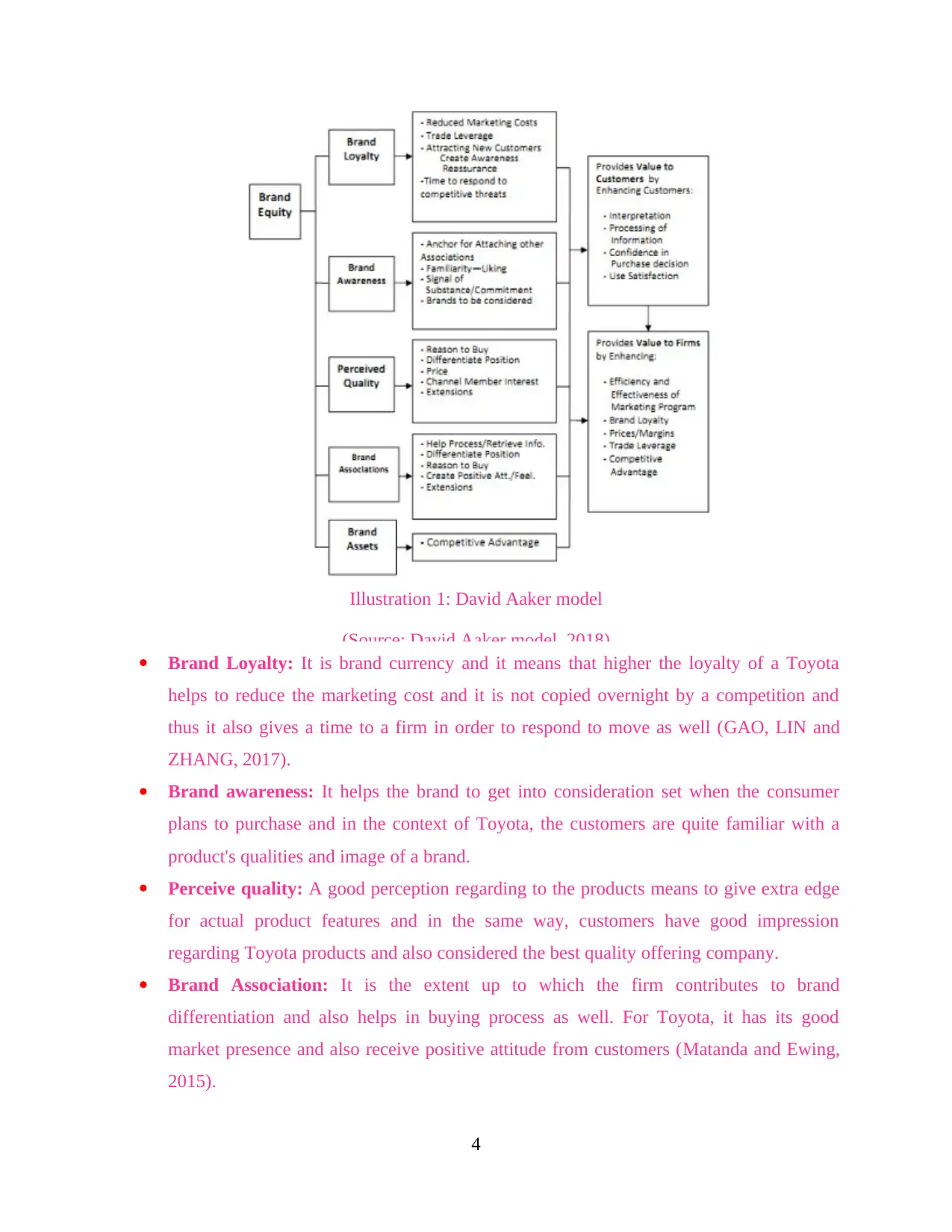
Brand Loyalty: It is brand currency and it means that higher the loyalty of a Toyota
helps to reduce the marketing cost and it is not copied overnight by a competition and
thus it also gives a time to a firm in order to respond to move as well (GAO, LIN and
ZHANG, 2017).
Brand awareness: It helps the brand to get into consideration set when the consumer
plans to purchase and in the context of Toyota, the customers are quite familiar with a
product's qualities and image of a brand.
Perceive quality: A good perception regarding to the products means to give extra edge
for actual product features and in the same way, customers have good impression
regarding Toyota products and also considered the best quality offering company.
Brand Association: It is the extent up to which the firm contributes to brand
differentiation and also helps in buying process as well. For Toyota, it has its good
market presence and also receive positive attitude from customers (Matanda and Ewing,
2015).
4
Illustration 1: David Aaker model
(Source: David Aaker model, 2018)
helps to reduce the marketing cost and it is not copied overnight by a competition and
thus it also gives a time to a firm in order to respond to move as well (GAO, LIN and
ZHANG, 2017).
Brand awareness: It helps the brand to get into consideration set when the consumer
plans to purchase and in the context of Toyota, the customers are quite familiar with a
product's qualities and image of a brand.
Perceive quality: A good perception regarding to the products means to give extra edge
for actual product features and in the same way, customers have good impression
regarding Toyota products and also considered the best quality offering company.
Brand Association: It is the extent up to which the firm contributes to brand
differentiation and also helps in buying process as well. For Toyota, it has its good
market presence and also receive positive attitude from customers (Matanda and Ewing,
2015).
4
Illustration 1: David Aaker model
(Source: David Aaker model, 2018)
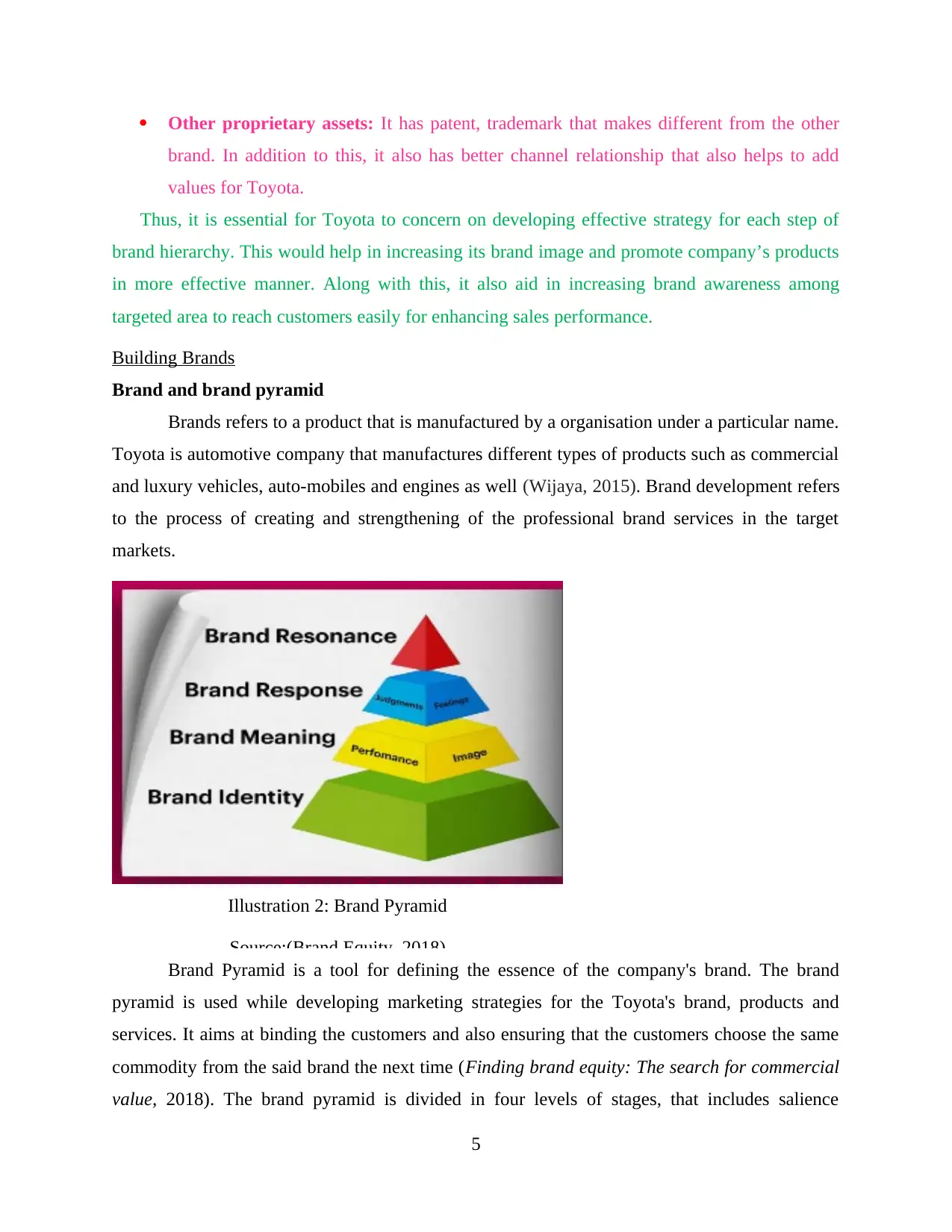
Other proprietary assets: It has patent, trademark that makes different from the other
brand. In addition to this, it also has better channel relationship that also helps to add
values for Toyota.
Thus, it is essential for Toyota to concern on developing effective strategy for each step of
brand hierarchy. This would help in increasing its brand image and promote company’s products
in more effective manner. Along with this, it also aid in increasing brand awareness among
targeted area to reach customers easily for enhancing sales performance.
Building Brands
Brand and brand pyramid
Brands refers to a product that is manufactured by a organisation under a particular name.
Toyota is automotive company that manufactures different types of products such as commercial
and luxury vehicles, auto-mobiles and engines as well (Wijaya, 2015). Brand development refers
to the process of creating and strengthening of the professional brand services in the target
markets.
Illustration 2: Brand Pyramid
Source:(Brand Equity, 2018)
Brand Pyramid is a tool for defining the essence of the company's brand. The brand
pyramid is used while developing marketing strategies for the Toyota's brand, products and
services. It aims at binding the customers and also ensuring that the customers choose the same
commodity from the said brand the next time (Finding brand equity: The search for commercial
value, 2018). The brand pyramid is divided in four levels of stages, that includes salience
5
brand. In addition to this, it also has better channel relationship that also helps to add
values for Toyota.
Thus, it is essential for Toyota to concern on developing effective strategy for each step of
brand hierarchy. This would help in increasing its brand image and promote company’s products
in more effective manner. Along with this, it also aid in increasing brand awareness among
targeted area to reach customers easily for enhancing sales performance.
Building Brands
Brand and brand pyramid
Brands refers to a product that is manufactured by a organisation under a particular name.
Toyota is automotive company that manufactures different types of products such as commercial
and luxury vehicles, auto-mobiles and engines as well (Wijaya, 2015). Brand development refers
to the process of creating and strengthening of the professional brand services in the target
markets.
Illustration 2: Brand Pyramid
Source:(Brand Equity, 2018)
Brand Pyramid is a tool for defining the essence of the company's brand. The brand
pyramid is used while developing marketing strategies for the Toyota's brand, products and
services. It aims at binding the customers and also ensuring that the customers choose the same
commodity from the said brand the next time (Finding brand equity: The search for commercial
value, 2018). The brand pyramid is divided in four levels of stages, that includes salience
5
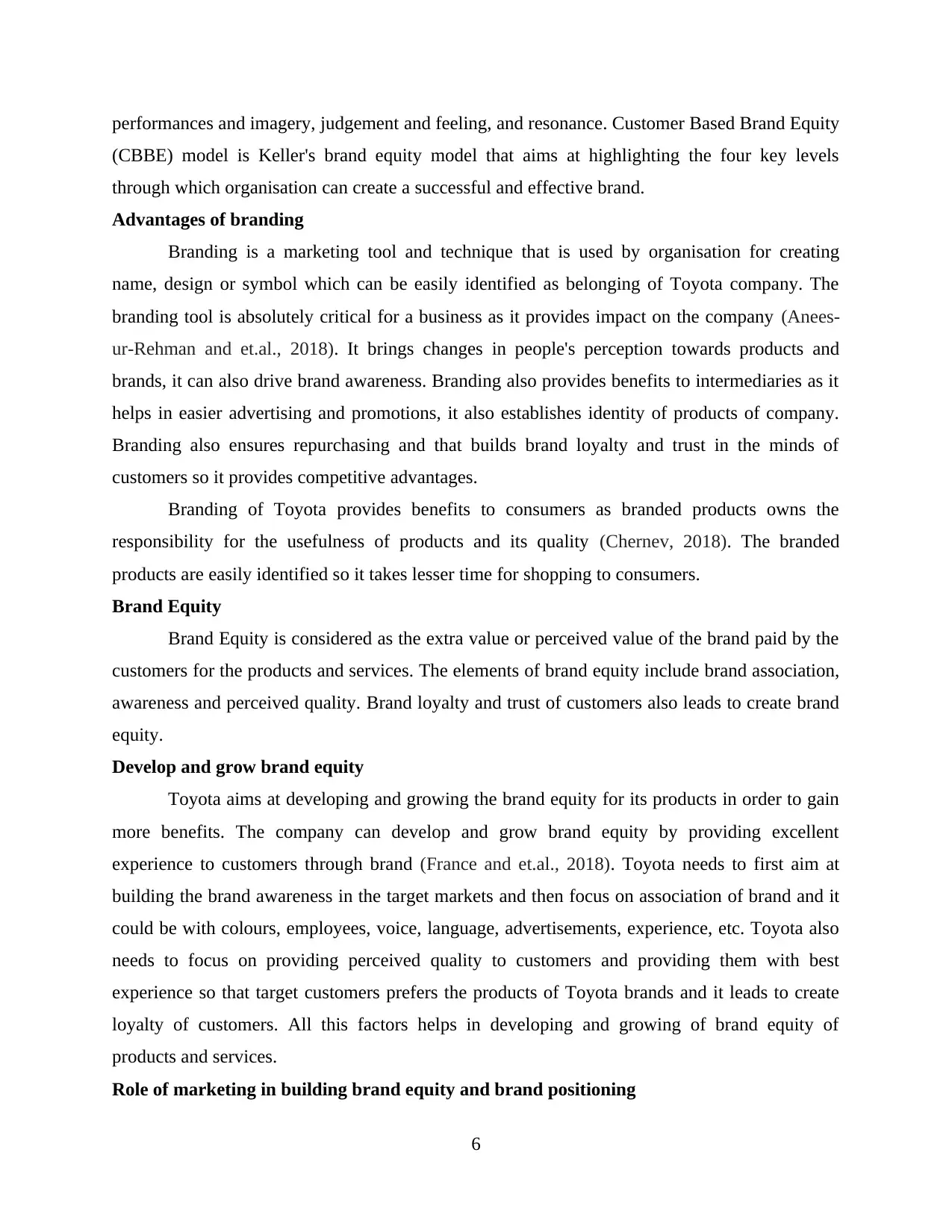
performances and imagery, judgement and feeling, and resonance. Customer Based Brand Equity
(CBBE) model is Keller's brand equity model that aims at highlighting the four key levels
through which organisation can create a successful and effective brand.
Advantages of branding
Branding is a marketing tool and technique that is used by organisation for creating
name, design or symbol which can be easily identified as belonging of Toyota company. The
branding tool is absolutely critical for a business as it provides impact on the company (Anees-
ur-Rehman and et.al., 2018). It brings changes in people's perception towards products and
brands, it can also drive brand awareness. Branding also provides benefits to intermediaries as it
helps in easier advertising and promotions, it also establishes identity of products of company.
Branding also ensures repurchasing and that builds brand loyalty and trust in the minds of
customers so it provides competitive advantages.
Branding of Toyota provides benefits to consumers as branded products owns the
responsibility for the usefulness of products and its quality (Chernev, 2018). The branded
products are easily identified so it takes lesser time for shopping to consumers.
Brand Equity
Brand Equity is considered as the extra value or perceived value of the brand paid by the
customers for the products and services. The elements of brand equity include brand association,
awareness and perceived quality. Brand loyalty and trust of customers also leads to create brand
equity.
Develop and grow brand equity
Toyota aims at developing and growing the brand equity for its products in order to gain
more benefits. The company can develop and grow brand equity by providing excellent
experience to customers through brand (France and et.al., 2018). Toyota needs to first aim at
building the brand awareness in the target markets and then focus on association of brand and it
could be with colours, employees, voice, language, advertisements, experience, etc. Toyota also
needs to focus on providing perceived quality to customers and providing them with best
experience so that target customers prefers the products of Toyota brands and it leads to create
loyalty of customers. All this factors helps in developing and growing of brand equity of
products and services.
Role of marketing in building brand equity and brand positioning
6
(CBBE) model is Keller's brand equity model that aims at highlighting the four key levels
through which organisation can create a successful and effective brand.
Advantages of branding
Branding is a marketing tool and technique that is used by organisation for creating
name, design or symbol which can be easily identified as belonging of Toyota company. The
branding tool is absolutely critical for a business as it provides impact on the company (Anees-
ur-Rehman and et.al., 2018). It brings changes in people's perception towards products and
brands, it can also drive brand awareness. Branding also provides benefits to intermediaries as it
helps in easier advertising and promotions, it also establishes identity of products of company.
Branding also ensures repurchasing and that builds brand loyalty and trust in the minds of
customers so it provides competitive advantages.
Branding of Toyota provides benefits to consumers as branded products owns the
responsibility for the usefulness of products and its quality (Chernev, 2018). The branded
products are easily identified so it takes lesser time for shopping to consumers.
Brand Equity
Brand Equity is considered as the extra value or perceived value of the brand paid by the
customers for the products and services. The elements of brand equity include brand association,
awareness and perceived quality. Brand loyalty and trust of customers also leads to create brand
equity.
Develop and grow brand equity
Toyota aims at developing and growing the brand equity for its products in order to gain
more benefits. The company can develop and grow brand equity by providing excellent
experience to customers through brand (France and et.al., 2018). Toyota needs to first aim at
building the brand awareness in the target markets and then focus on association of brand and it
could be with colours, employees, voice, language, advertisements, experience, etc. Toyota also
needs to focus on providing perceived quality to customers and providing them with best
experience so that target customers prefers the products of Toyota brands and it leads to create
loyalty of customers. All this factors helps in developing and growing of brand equity of
products and services.
Role of marketing in building brand equity and brand positioning
6
Secure Best Marks with AI Grader
Need help grading? Try our AI Grader for instant feedback on your assignments.
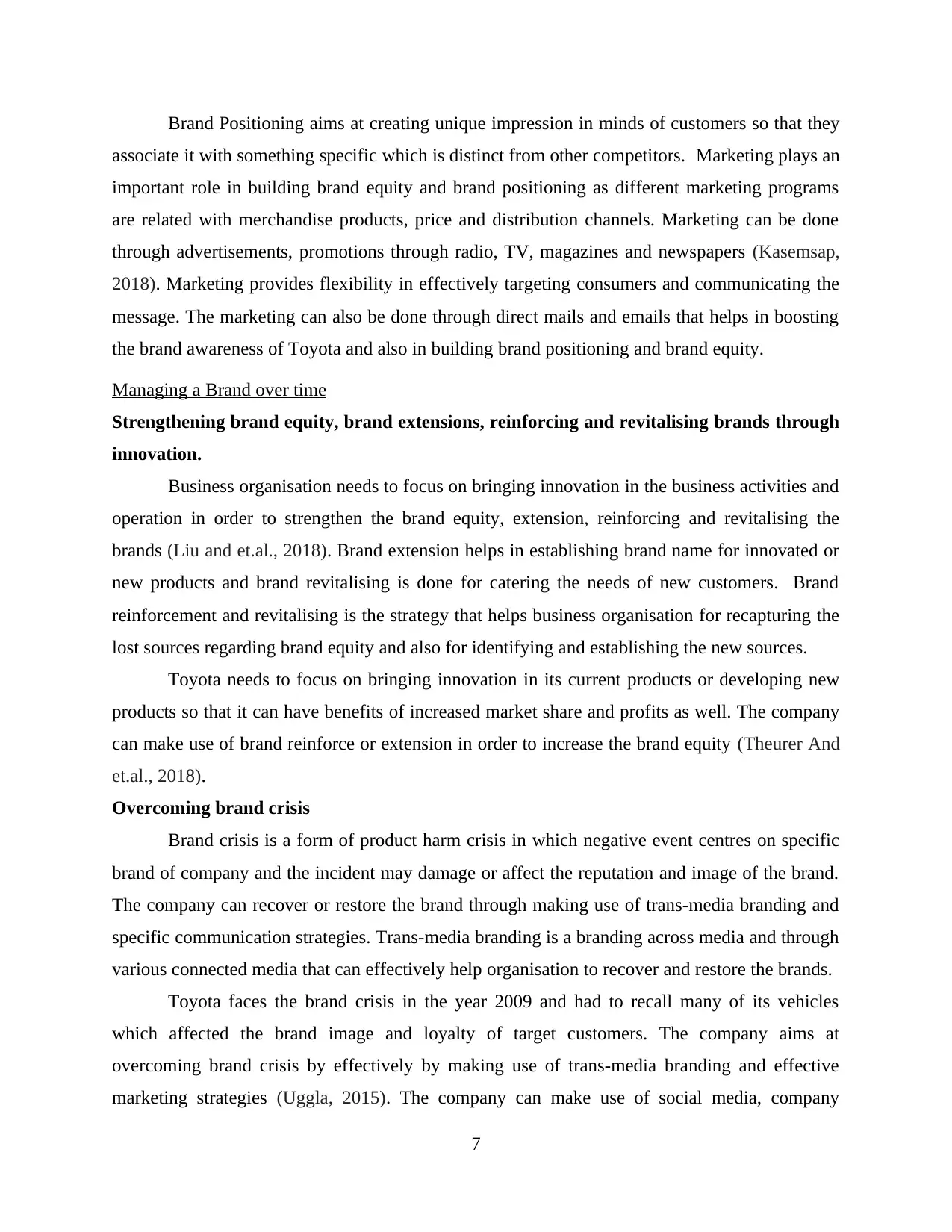
Brand Positioning aims at creating unique impression in minds of customers so that they
associate it with something specific which is distinct from other competitors. Marketing plays an
important role in building brand equity and brand positioning as different marketing programs
are related with merchandise products, price and distribution channels. Marketing can be done
through advertisements, promotions through radio, TV, magazines and newspapers (Kasemsap,
2018). Marketing provides flexibility in effectively targeting consumers and communicating the
message. The marketing can also be done through direct mails and emails that helps in boosting
the brand awareness of Toyota and also in building brand positioning and brand equity.
Managing a Brand over time
Strengthening brand equity, brand extensions, reinforcing and revitalising brands through
innovation.
Business organisation needs to focus on bringing innovation in the business activities and
operation in order to strengthen the brand equity, extension, reinforcing and revitalising the
brands (Liu and et.al., 2018). Brand extension helps in establishing brand name for innovated or
new products and brand revitalising is done for catering the needs of new customers. Brand
reinforcement and revitalising is the strategy that helps business organisation for recapturing the
lost sources regarding brand equity and also for identifying and establishing the new sources.
Toyota needs to focus on bringing innovation in its current products or developing new
products so that it can have benefits of increased market share and profits as well. The company
can make use of brand reinforce or extension in order to increase the brand equity (Theurer And
et.al., 2018).
Overcoming brand crisis
Brand crisis is a form of product harm crisis in which negative event centres on specific
brand of company and the incident may damage or affect the reputation and image of the brand.
The company can recover or restore the brand through making use of trans-media branding and
specific communication strategies. Trans-media branding is a branding across media and through
various connected media that can effectively help organisation to recover and restore the brands.
Toyota faces the brand crisis in the year 2009 and had to recall many of its vehicles
which affected the brand image and loyalty of target customers. The company aims at
overcoming brand crisis by effectively by making use of trans-media branding and effective
marketing strategies (Uggla, 2015). The company can make use of social media, company
7
associate it with something specific which is distinct from other competitors. Marketing plays an
important role in building brand equity and brand positioning as different marketing programs
are related with merchandise products, price and distribution channels. Marketing can be done
through advertisements, promotions through radio, TV, magazines and newspapers (Kasemsap,
2018). Marketing provides flexibility in effectively targeting consumers and communicating the
message. The marketing can also be done through direct mails and emails that helps in boosting
the brand awareness of Toyota and also in building brand positioning and brand equity.
Managing a Brand over time
Strengthening brand equity, brand extensions, reinforcing and revitalising brands through
innovation.
Business organisation needs to focus on bringing innovation in the business activities and
operation in order to strengthen the brand equity, extension, reinforcing and revitalising the
brands (Liu and et.al., 2018). Brand extension helps in establishing brand name for innovated or
new products and brand revitalising is done for catering the needs of new customers. Brand
reinforcement and revitalising is the strategy that helps business organisation for recapturing the
lost sources regarding brand equity and also for identifying and establishing the new sources.
Toyota needs to focus on bringing innovation in its current products or developing new
products so that it can have benefits of increased market share and profits as well. The company
can make use of brand reinforce or extension in order to increase the brand equity (Theurer And
et.al., 2018).
Overcoming brand crisis
Brand crisis is a form of product harm crisis in which negative event centres on specific
brand of company and the incident may damage or affect the reputation and image of the brand.
The company can recover or restore the brand through making use of trans-media branding and
specific communication strategies. Trans-media branding is a branding across media and through
various connected media that can effectively help organisation to recover and restore the brands.
Toyota faces the brand crisis in the year 2009 and had to recall many of its vehicles
which affected the brand image and loyalty of target customers. The company aims at
overcoming brand crisis by effectively by making use of trans-media branding and effective
marketing strategies (Uggla, 2015). The company can make use of social media, company
7
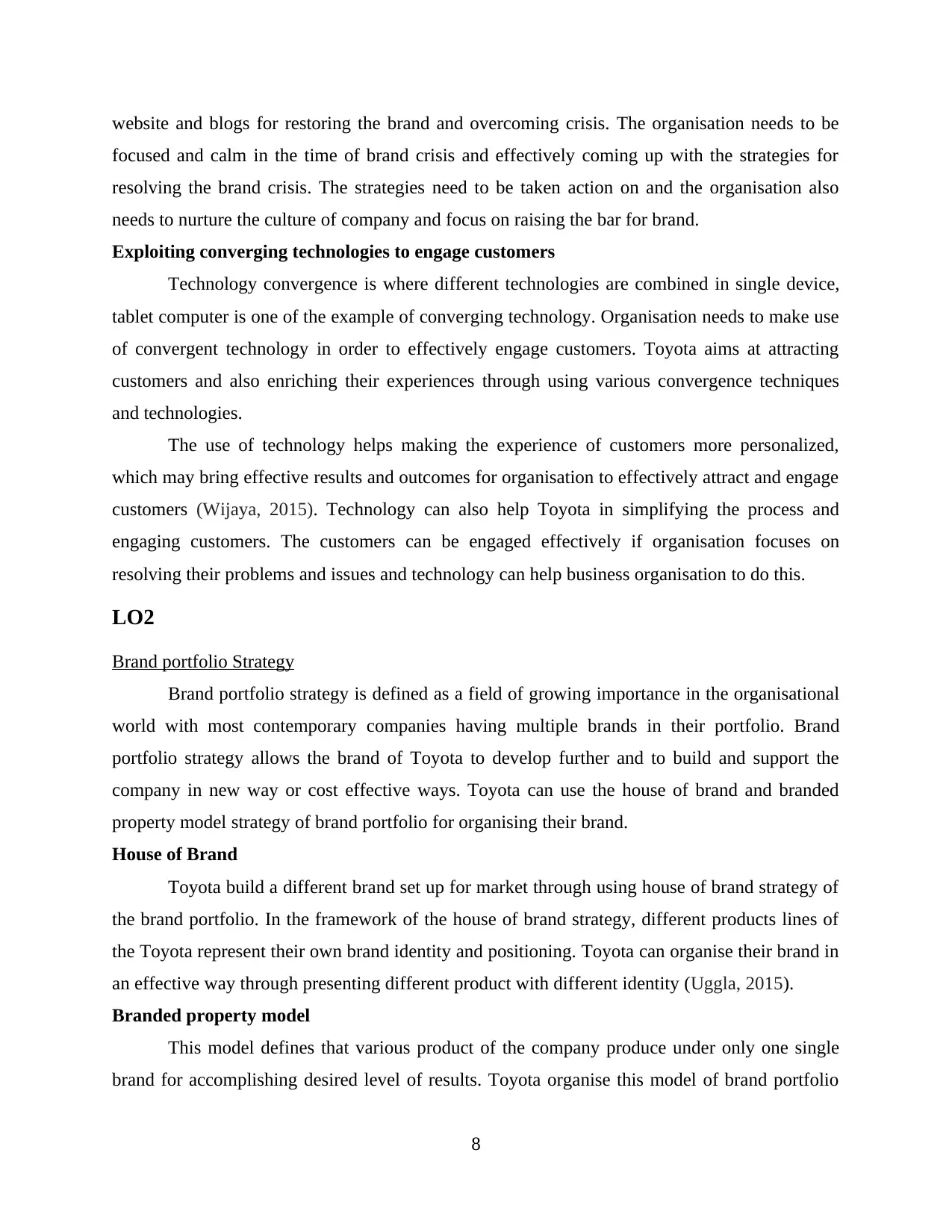
website and blogs for restoring the brand and overcoming crisis. The organisation needs to be
focused and calm in the time of brand crisis and effectively coming up with the strategies for
resolving the brand crisis. The strategies need to be taken action on and the organisation also
needs to nurture the culture of company and focus on raising the bar for brand.
Exploiting converging technologies to engage customers
Technology convergence is where different technologies are combined in single device,
tablet computer is one of the example of converging technology. Organisation needs to make use
of convergent technology in order to effectively engage customers. Toyota aims at attracting
customers and also enriching their experiences through using various convergence techniques
and technologies.
The use of technology helps making the experience of customers more personalized,
which may bring effective results and outcomes for organisation to effectively attract and engage
customers (Wijaya, 2015). Technology can also help Toyota in simplifying the process and
engaging customers. The customers can be engaged effectively if organisation focuses on
resolving their problems and issues and technology can help business organisation to do this.
LO2
Brand portfolio Strategy
Brand portfolio strategy is defined as a field of growing importance in the organisational
world with most contemporary companies having multiple brands in their portfolio. Brand
portfolio strategy allows the brand of Toyota to develop further and to build and support the
company in new way or cost effective ways. Toyota can use the house of brand and branded
property model strategy of brand portfolio for organising their brand.
House of Brand
Toyota build a different brand set up for market through using house of brand strategy of
the brand portfolio. In the framework of the house of brand strategy, different products lines of
the Toyota represent their own brand identity and positioning. Toyota can organise their brand in
an effective way through presenting different product with different identity (Uggla, 2015).
Branded property model
This model defines that various product of the company produce under only one single
brand for accomplishing desired level of results. Toyota organise this model of brand portfolio
8
focused and calm in the time of brand crisis and effectively coming up with the strategies for
resolving the brand crisis. The strategies need to be taken action on and the organisation also
needs to nurture the culture of company and focus on raising the bar for brand.
Exploiting converging technologies to engage customers
Technology convergence is where different technologies are combined in single device,
tablet computer is one of the example of converging technology. Organisation needs to make use
of convergent technology in order to effectively engage customers. Toyota aims at attracting
customers and also enriching their experiences through using various convergence techniques
and technologies.
The use of technology helps making the experience of customers more personalized,
which may bring effective results and outcomes for organisation to effectively attract and engage
customers (Wijaya, 2015). Technology can also help Toyota in simplifying the process and
engaging customers. The customers can be engaged effectively if organisation focuses on
resolving their problems and issues and technology can help business organisation to do this.
LO2
Brand portfolio Strategy
Brand portfolio strategy is defined as a field of growing importance in the organisational
world with most contemporary companies having multiple brands in their portfolio. Brand
portfolio strategy allows the brand of Toyota to develop further and to build and support the
company in new way or cost effective ways. Toyota can use the house of brand and branded
property model strategy of brand portfolio for organising their brand.
House of Brand
Toyota build a different brand set up for market through using house of brand strategy of
the brand portfolio. In the framework of the house of brand strategy, different products lines of
the Toyota represent their own brand identity and positioning. Toyota can organise their brand in
an effective way through presenting different product with different identity (Uggla, 2015).
Branded property model
This model defines that various product of the company produce under only one single
brand for accomplishing desired level of results. Toyota organise this model of brand portfolio
8

through sharing same vision and values at the all business units, it requires better relationship
and cooperation among company headquarter and their various business units.
Brand hierarchy
Brand hierarchy defined as process of graphically portraying a firms branding strategy by
presenting number and nature of common and distinctive brand element across the firms product.
Toyota organise this brand hierarchy for achieving company goals through attracting consumers
by displaying the various new and existing product of the company with their price and quality.
Toyota organise the corporate brand level of brand hierarchy through presenting
company name somewhere on the products, although the name of company subsidiary may
appear instead of the Toyota. Family brand used in more than one product category but is not
compulsory the name of the company. Toyota use the family brand level for efficient means to
link common association to multiple but distinct products. Toyota can effectively introduce a
new brand cost as lower through applying existing family brand which results in increasing the
demand of new product. Individual brand level defines that individual brand are restricted to
only one product category. Through using this individual brand level Toyota can customize the
brand and also using its supporting marketing activity to meet the specific requirement of the
consumers (Wijaya, 2015.).
Brand equity plays an important role in building a different level of the hierarchy because
it presents the total value of the brand as a separate assets in the organisation. The brands equity
of Toyota is usually based on the brand awareness, loyalty, perceived quality and strong brand
association. It also fulfil the consumers need and maintaining the relationship well with their
consumers.
Customer based brand equity model is a significant tool for managing and developing the
brand of the Toyota because it includes the four level of brand equity pyramid such as identity,
meaning, response and relationship which helps in building a better brand image of the company
at the market place through providing product information to consumers.
Market research also plays an important role as key brand management tool which
analyse the data about product and services of the firm. Toyota use this tool for improving brand
image through open ended communication or survey and also getting feedback about its
products.
9
and cooperation among company headquarter and their various business units.
Brand hierarchy
Brand hierarchy defined as process of graphically portraying a firms branding strategy by
presenting number and nature of common and distinctive brand element across the firms product.
Toyota organise this brand hierarchy for achieving company goals through attracting consumers
by displaying the various new and existing product of the company with their price and quality.
Toyota organise the corporate brand level of brand hierarchy through presenting
company name somewhere on the products, although the name of company subsidiary may
appear instead of the Toyota. Family brand used in more than one product category but is not
compulsory the name of the company. Toyota use the family brand level for efficient means to
link common association to multiple but distinct products. Toyota can effectively introduce a
new brand cost as lower through applying existing family brand which results in increasing the
demand of new product. Individual brand level defines that individual brand are restricted to
only one product category. Through using this individual brand level Toyota can customize the
brand and also using its supporting marketing activity to meet the specific requirement of the
consumers (Wijaya, 2015.).
Brand equity plays an important role in building a different level of the hierarchy because
it presents the total value of the brand as a separate assets in the organisation. The brands equity
of Toyota is usually based on the brand awareness, loyalty, perceived quality and strong brand
association. It also fulfil the consumers need and maintaining the relationship well with their
consumers.
Customer based brand equity model is a significant tool for managing and developing the
brand of the Toyota because it includes the four level of brand equity pyramid such as identity,
meaning, response and relationship which helps in building a better brand image of the company
at the market place through providing product information to consumers.
Market research also plays an important role as key brand management tool which
analyse the data about product and services of the firm. Toyota use this tool for improving brand
image through open ended communication or survey and also getting feedback about its
products.
9
Paraphrase This Document
Need a fresh take? Get an instant paraphrase of this document with our AI Paraphraser
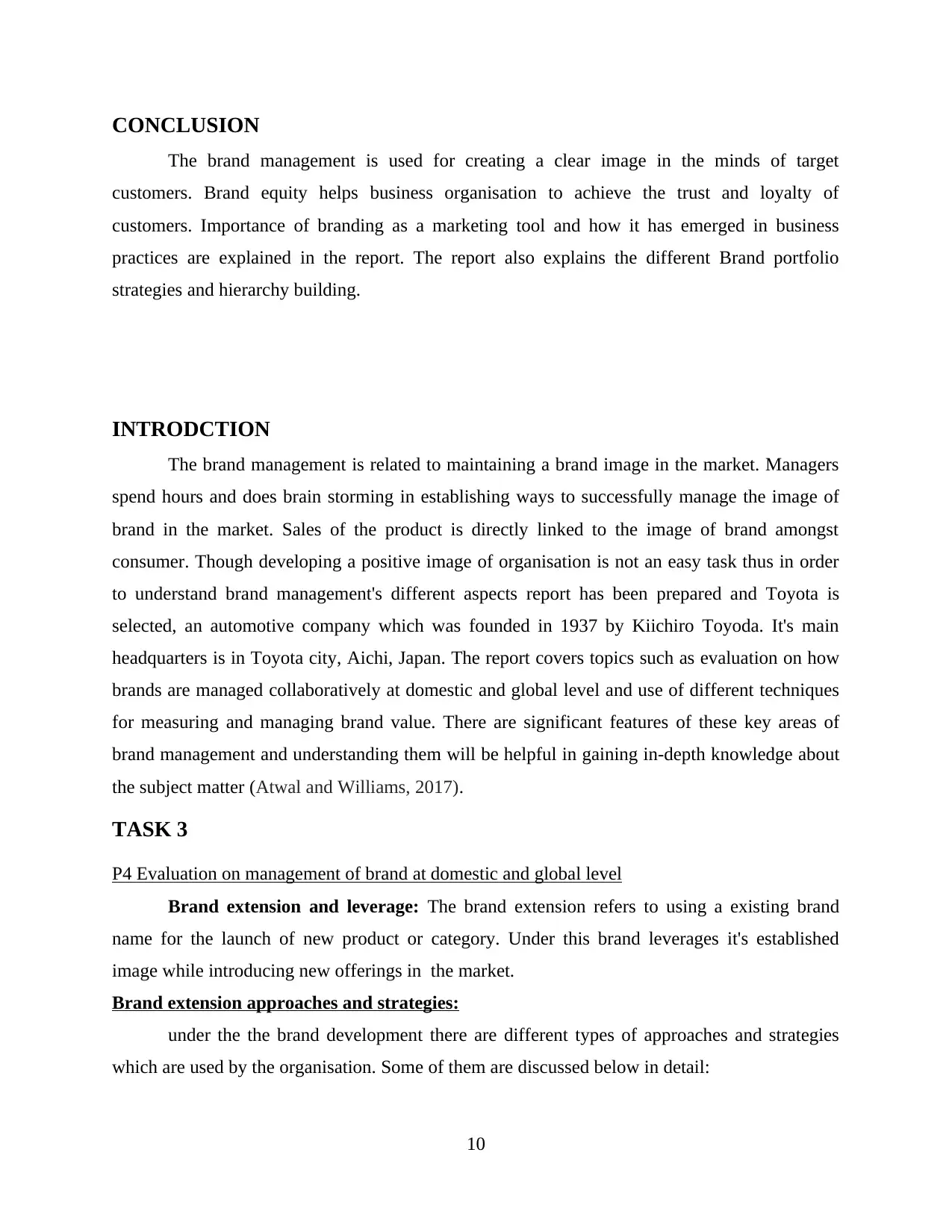
CONCLUSION
The brand management is used for creating a clear image in the minds of target
customers. Brand equity helps business organisation to achieve the trust and loyalty of
customers. Importance of branding as a marketing tool and how it has emerged in business
practices are explained in the report. The report also explains the different Brand portfolio
strategies and hierarchy building.
INTRODCTION
The brand management is related to maintaining a brand image in the market. Managers
spend hours and does brain storming in establishing ways to successfully manage the image of
brand in the market. Sales of the product is directly linked to the image of brand amongst
consumer. Though developing a positive image of organisation is not an easy task thus in order
to understand brand management's different aspects report has been prepared and Toyota is
selected, an automotive company which was founded in 1937 by Kiichiro Toyoda. It's main
headquarters is in Toyota city, Aichi, Japan. The report covers topics such as evaluation on how
brands are managed collaboratively at domestic and global level and use of different techniques
for measuring and managing brand value. There are significant features of these key areas of
brand management and understanding them will be helpful in gaining in-depth knowledge about
the subject matter (Atwal and Williams, 2017).
TASK 3
P4 Evaluation on management of brand at domestic and global level
Brand extension and leverage: The brand extension refers to using a existing brand
name for the launch of new product or category. Under this brand leverages it's established
image while introducing new offerings in the market.
Brand extension approaches and strategies:
under the the brand development there are different types of approaches and strategies
which are used by the organisation. Some of them are discussed below in detail:
10
The brand management is used for creating a clear image in the minds of target
customers. Brand equity helps business organisation to achieve the trust and loyalty of
customers. Importance of branding as a marketing tool and how it has emerged in business
practices are explained in the report. The report also explains the different Brand portfolio
strategies and hierarchy building.
INTRODCTION
The brand management is related to maintaining a brand image in the market. Managers
spend hours and does brain storming in establishing ways to successfully manage the image of
brand in the market. Sales of the product is directly linked to the image of brand amongst
consumer. Though developing a positive image of organisation is not an easy task thus in order
to understand brand management's different aspects report has been prepared and Toyota is
selected, an automotive company which was founded in 1937 by Kiichiro Toyoda. It's main
headquarters is in Toyota city, Aichi, Japan. The report covers topics such as evaluation on how
brands are managed collaboratively at domestic and global level and use of different techniques
for measuring and managing brand value. There are significant features of these key areas of
brand management and understanding them will be helpful in gaining in-depth knowledge about
the subject matter (Atwal and Williams, 2017).
TASK 3
P4 Evaluation on management of brand at domestic and global level
Brand extension and leverage: The brand extension refers to using a existing brand
name for the launch of new product or category. Under this brand leverages it's established
image while introducing new offerings in the market.
Brand extension approaches and strategies:
under the the brand development there are different types of approaches and strategies
which are used by the organisation. Some of them are discussed below in detail:
10
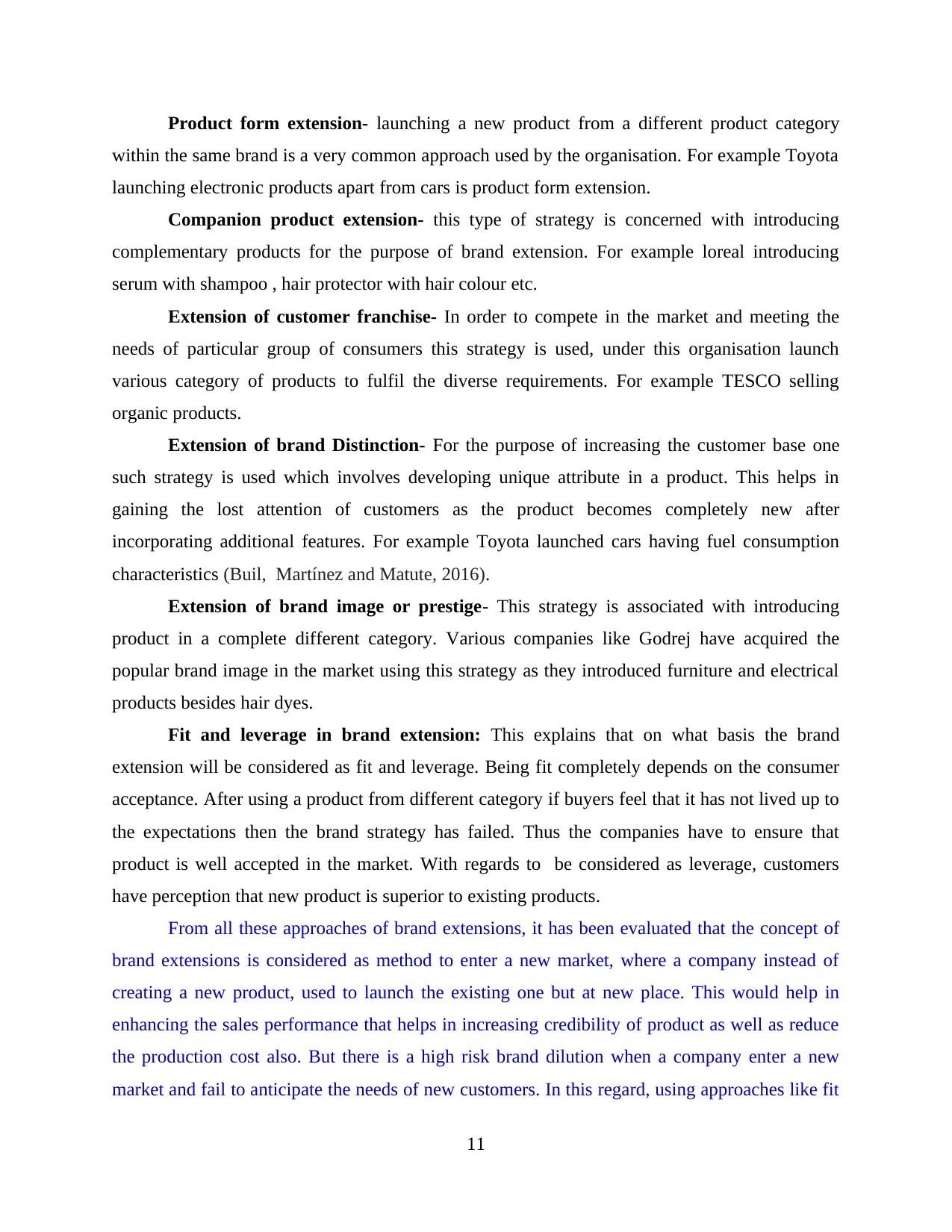
Product form extension- launching a new product from a different product category
within the same brand is a very common approach used by the organisation. For example Toyota
launching electronic products apart from cars is product form extension.
Companion product extension- this type of strategy is concerned with introducing
complementary products for the purpose of brand extension. For example loreal introducing
serum with shampoo , hair protector with hair colour etc.
Extension of customer franchise- In order to compete in the market and meeting the
needs of particular group of consumers this strategy is used, under this organisation launch
various category of products to fulfil the diverse requirements. For example TESCO selling
organic products.
Extension of brand Distinction- For the purpose of increasing the customer base one
such strategy is used which involves developing unique attribute in a product. This helps in
gaining the lost attention of customers as the product becomes completely new after
incorporating additional features. For example Toyota launched cars having fuel consumption
characteristics (Buil, Martínez and Matute, 2016).
Extension of brand image or prestige- This strategy is associated with introducing
product in a complete different category. Various companies like Godrej have acquired the
popular brand image in the market using this strategy as they introduced furniture and electrical
products besides hair dyes.
Fit and leverage in brand extension: This explains that on what basis the brand
extension will be considered as fit and leverage. Being fit completely depends on the consumer
acceptance. After using a product from different category if buyers feel that it has not lived up to
the expectations then the brand strategy has failed. Thus the companies have to ensure that
product is well accepted in the market. With regards to be considered as leverage, customers
have perception that new product is superior to existing products.
From all these approaches of brand extensions, it has been evaluated that the concept of
brand extensions is considered as method to enter a new market, where a company instead of
creating a new product, used to launch the existing one but at new place. This would help in
enhancing the sales performance that helps in increasing credibility of product as well as reduce
the production cost also. But there is a high risk brand dilution when a company enter a new
market and fail to anticipate the needs of new customers. In this regard, using approaches like fit
11
within the same brand is a very common approach used by the organisation. For example Toyota
launching electronic products apart from cars is product form extension.
Companion product extension- this type of strategy is concerned with introducing
complementary products for the purpose of brand extension. For example loreal introducing
serum with shampoo , hair protector with hair colour etc.
Extension of customer franchise- In order to compete in the market and meeting the
needs of particular group of consumers this strategy is used, under this organisation launch
various category of products to fulfil the diverse requirements. For example TESCO selling
organic products.
Extension of brand Distinction- For the purpose of increasing the customer base one
such strategy is used which involves developing unique attribute in a product. This helps in
gaining the lost attention of customers as the product becomes completely new after
incorporating additional features. For example Toyota launched cars having fuel consumption
characteristics (Buil, Martínez and Matute, 2016).
Extension of brand image or prestige- This strategy is associated with introducing
product in a complete different category. Various companies like Godrej have acquired the
popular brand image in the market using this strategy as they introduced furniture and electrical
products besides hair dyes.
Fit and leverage in brand extension: This explains that on what basis the brand
extension will be considered as fit and leverage. Being fit completely depends on the consumer
acceptance. After using a product from different category if buyers feel that it has not lived up to
the expectations then the brand strategy has failed. Thus the companies have to ensure that
product is well accepted in the market. With regards to be considered as leverage, customers
have perception that new product is superior to existing products.
From all these approaches of brand extensions, it has been evaluated that the concept of
brand extensions is considered as method to enter a new market, where a company instead of
creating a new product, used to launch the existing one but at new place. This would help in
enhancing the sales performance that helps in increasing credibility of product as well as reduce
the production cost also. But there is a high risk brand dilution when a company enter a new
market and fail to anticipate the needs of new customers. In this regard, using approaches like fit
11
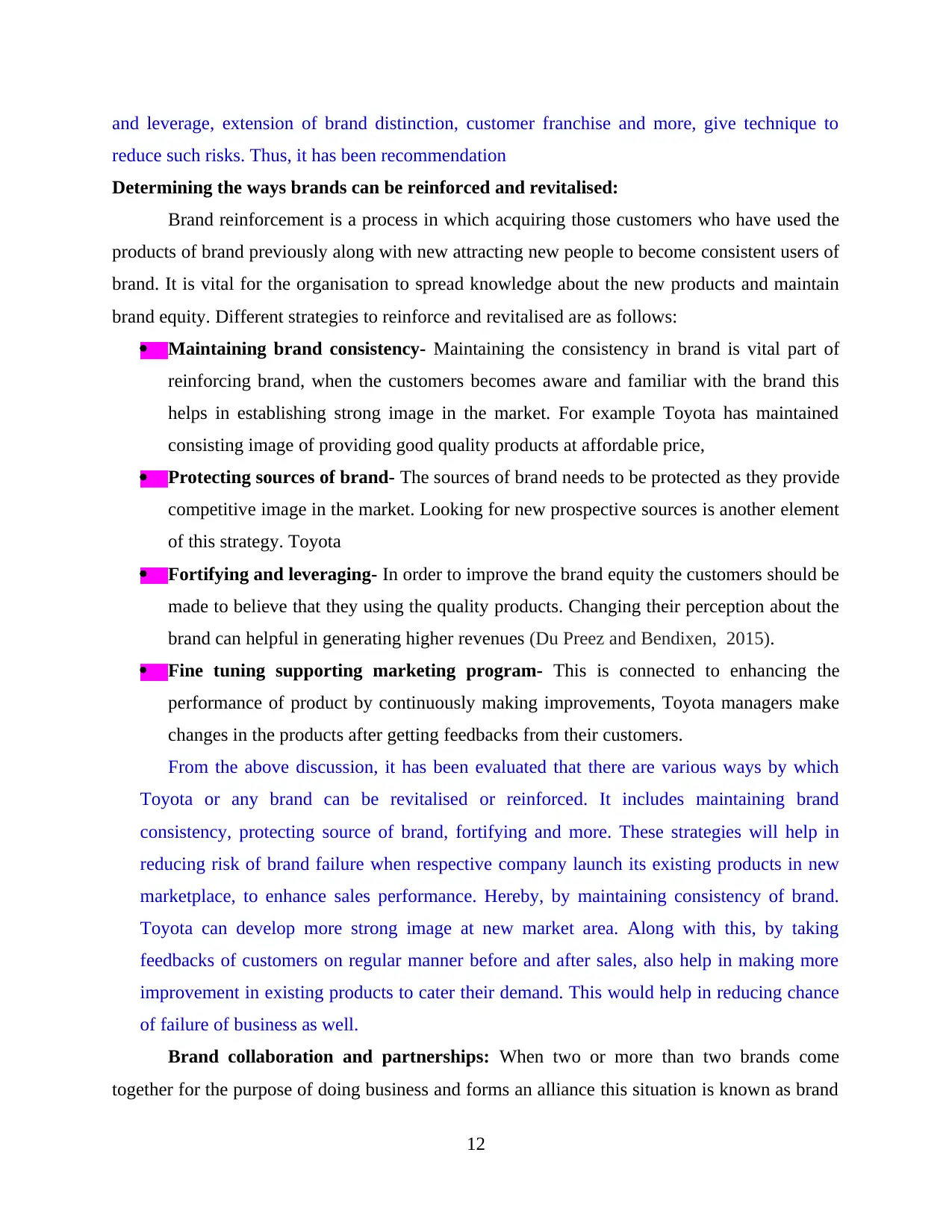
and leverage, extension of brand distinction, customer franchise and more, give technique to
reduce such risks. Thus, it has been recommendation
Determining the ways brands can be reinforced and revitalised:
Brand reinforcement is a process in which acquiring those customers who have used the
products of brand previously along with new attracting new people to become consistent users of
brand. It is vital for the organisation to spread knowledge about the new products and maintain
brand equity. Different strategies to reinforce and revitalised are as follows:
Maintaining brand consistency- Maintaining the consistency in brand is vital part of
reinforcing brand, when the customers becomes aware and familiar with the brand this
helps in establishing strong image in the market. For example Toyota has maintained
consisting image of providing good quality products at affordable price,
Protecting sources of brand- The sources of brand needs to be protected as they provide
competitive image in the market. Looking for new prospective sources is another element
of this strategy. Toyota
Fortifying and leveraging- In order to improve the brand equity the customers should be
made to believe that they using the quality products. Changing their perception about the
brand can helpful in generating higher revenues (Du Preez and Bendixen, 2015).
Fine tuning supporting marketing program- This is connected to enhancing the
performance of product by continuously making improvements, Toyota managers make
changes in the products after getting feedbacks from their customers.
From the above discussion, it has been evaluated that there are various ways by which
Toyota or any brand can be revitalised or reinforced. It includes maintaining brand
consistency, protecting source of brand, fortifying and more. These strategies will help in
reducing risk of brand failure when respective company launch its existing products in new
marketplace, to enhance sales performance. Hereby, by maintaining consistency of brand.
Toyota can develop more strong image at new market area. Along with this, by taking
feedbacks of customers on regular manner before and after sales, also help in making more
improvement in existing products to cater their demand. This would help in reducing chance
of failure of business as well.
Brand collaboration and partnerships: When two or more than two brands come
together for the purpose of doing business and forms an alliance this situation is known as brand
12
reduce such risks. Thus, it has been recommendation
Determining the ways brands can be reinforced and revitalised:
Brand reinforcement is a process in which acquiring those customers who have used the
products of brand previously along with new attracting new people to become consistent users of
brand. It is vital for the organisation to spread knowledge about the new products and maintain
brand equity. Different strategies to reinforce and revitalised are as follows:
Maintaining brand consistency- Maintaining the consistency in brand is vital part of
reinforcing brand, when the customers becomes aware and familiar with the brand this
helps in establishing strong image in the market. For example Toyota has maintained
consisting image of providing good quality products at affordable price,
Protecting sources of brand- The sources of brand needs to be protected as they provide
competitive image in the market. Looking for new prospective sources is another element
of this strategy. Toyota
Fortifying and leveraging- In order to improve the brand equity the customers should be
made to believe that they using the quality products. Changing their perception about the
brand can helpful in generating higher revenues (Du Preez and Bendixen, 2015).
Fine tuning supporting marketing program- This is connected to enhancing the
performance of product by continuously making improvements, Toyota managers make
changes in the products after getting feedbacks from their customers.
From the above discussion, it has been evaluated that there are various ways by which
Toyota or any brand can be revitalised or reinforced. It includes maintaining brand
consistency, protecting source of brand, fortifying and more. These strategies will help in
reducing risk of brand failure when respective company launch its existing products in new
marketplace, to enhance sales performance. Hereby, by maintaining consistency of brand.
Toyota can develop more strong image at new market area. Along with this, by taking
feedbacks of customers on regular manner before and after sales, also help in making more
improvement in existing products to cater their demand. This would help in reducing chance
of failure of business as well.
Brand collaboration and partnerships: When two or more than two brands come
together for the purpose of doing business and forms an alliance this situation is known as brand
12
Secure Best Marks with AI Grader
Need help grading? Try our AI Grader for instant feedback on your assignments.

collaboration. In order to deal with the complex business situations like changing trends, taste
and preferences of customers this strategy is used by the organisation. From the growth
perceptive it has various advantages. Toyota collaborated with Suzuki, under the business
partnership the strengths of Toyota having an efficiency in electrification while Suzuki is known
for producing compact vehicles are the reason for growth of the brand (Ertimur and Coskuner-
Balli, 2015).
Global branding and positioning: When the organisations decides to sell the goods and
services in other parts of the world global branding strategy is adopted. For example changes in
the pricing structure can be made where developing countries are concerned. It helps in attracting
and increasing the customer base in the foreign markets. On the other hand brand positioning is
targeting particular segment of group with similar strategy which was used domestically or
something new on global level.
Brands share partnerships at domestic as well as international level though at global level
it is not a feasible option due to changes in the operations of business, culture languages etc. The
brands should have common purpose and goal and then agree to merge. At domestic level there
are more consistency, loyalty, awareness amongst the customers that leads to the ease in the
growth of brand.
TASK 4
P5 techniques for measuring and managing brand value
Measuring brand involves determining the strengths and weakness of brands, this allows
managers to take necessary steps to overcome those areas where organisation lacks and make use
of it's strengths to further improve the position of brand (Zhang, 2015).
For measuring brand awareness:
Surveys- These are useful tool adopted by many companies to analyse the
response of customers towards the brand. Through email telephones, even on
websites surveys can be conducted. It helps in understanding customers
perception about the brand along with their recall value.
Website traffic- Assessing the traffic on websites is another tool, it shows that
customers are looking for the new offering of brand. Some of the software even
shows the complete profile of visitors who are visiting the company page.
13
and preferences of customers this strategy is used by the organisation. From the growth
perceptive it has various advantages. Toyota collaborated with Suzuki, under the business
partnership the strengths of Toyota having an efficiency in electrification while Suzuki is known
for producing compact vehicles are the reason for growth of the brand (Ertimur and Coskuner-
Balli, 2015).
Global branding and positioning: When the organisations decides to sell the goods and
services in other parts of the world global branding strategy is adopted. For example changes in
the pricing structure can be made where developing countries are concerned. It helps in attracting
and increasing the customer base in the foreign markets. On the other hand brand positioning is
targeting particular segment of group with similar strategy which was used domestically or
something new on global level.
Brands share partnerships at domestic as well as international level though at global level
it is not a feasible option due to changes in the operations of business, culture languages etc. The
brands should have common purpose and goal and then agree to merge. At domestic level there
are more consistency, loyalty, awareness amongst the customers that leads to the ease in the
growth of brand.
TASK 4
P5 techniques for measuring and managing brand value
Measuring brand involves determining the strengths and weakness of brands, this allows
managers to take necessary steps to overcome those areas where organisation lacks and make use
of it's strengths to further improve the position of brand (Zhang, 2015).
For measuring brand awareness:
Surveys- These are useful tool adopted by many companies to analyse the
response of customers towards the brand. Through email telephones, even on
websites surveys can be conducted. It helps in understanding customers
perception about the brand along with their recall value.
Website traffic- Assessing the traffic on websites is another tool, it shows that
customers are looking for the new offering of brand. Some of the software even
shows the complete profile of visitors who are visiting the company page.
13

Measuring market share:
Financial metrics- Sales of the brand is directly related to the brand equity, in order to
determine the market share of the product different aspects of financial metrics such as
premium price over competition, customer lifetime value, average transaction value etc
are part of this techniques (Heding, Knudtzen and Bjerre, 2015).
Measuring customer attitudes:
Preference metrics- This techniques analyses the different ways to determine the buyers
attitude. It states how relevant the brand is, whether customers finds it better than the competitors
or not. Also what is the value of brand in the lives of customers and if the products and services
are easily accessible.
Purchasing intent:
Funnel model- This method identifies the purchasing behaviour of buyers along with the
price brand and purchasing intent. It can be performed by asking customers to select the brand
out of many and provide suggestion for those which are not being chosen. This is an easiest way
to understand the reason behind the purchasing.
In this regard, by using above strategies, managers of Toyota can also analyse its strengths and
weaknesses in following way -
Toyota's Strengths (internal strategic
factor)
Toyota's Weaknesses (internal strategic
factor)
Strong Brand Image
Global supply chain
Rapid innovation capabilities
Hierarchical organisational structure
Negative publicity
Dependence of suppliers
From this analysis, it has been analysed that having strong brand image is one of the
strongest point of Toyota, which helps in grabbing high attention of new customers at new
marketplace after launching the existing products over there. But due to negative publicity like
recall rates will affect cause failure in expansion as well. Therefore, by making improvement in
this area through introducing concept of Green Vehicle Technology, it can bring attention of
customers again towards its brand.
Brand equity audit and brand tracking techniques:
14
Financial metrics- Sales of the brand is directly related to the brand equity, in order to
determine the market share of the product different aspects of financial metrics such as
premium price over competition, customer lifetime value, average transaction value etc
are part of this techniques (Heding, Knudtzen and Bjerre, 2015).
Measuring customer attitudes:
Preference metrics- This techniques analyses the different ways to determine the buyers
attitude. It states how relevant the brand is, whether customers finds it better than the competitors
or not. Also what is the value of brand in the lives of customers and if the products and services
are easily accessible.
Purchasing intent:
Funnel model- This method identifies the purchasing behaviour of buyers along with the
price brand and purchasing intent. It can be performed by asking customers to select the brand
out of many and provide suggestion for those which are not being chosen. This is an easiest way
to understand the reason behind the purchasing.
In this regard, by using above strategies, managers of Toyota can also analyse its strengths and
weaknesses in following way -
Toyota's Strengths (internal strategic
factor)
Toyota's Weaknesses (internal strategic
factor)
Strong Brand Image
Global supply chain
Rapid innovation capabilities
Hierarchical organisational structure
Negative publicity
Dependence of suppliers
From this analysis, it has been analysed that having strong brand image is one of the
strongest point of Toyota, which helps in grabbing high attention of new customers at new
marketplace after launching the existing products over there. But due to negative publicity like
recall rates will affect cause failure in expansion as well. Therefore, by making improvement in
this area through introducing concept of Green Vehicle Technology, it can bring attention of
customers again towards its brand.
Brand equity audit and brand tracking techniques:
14
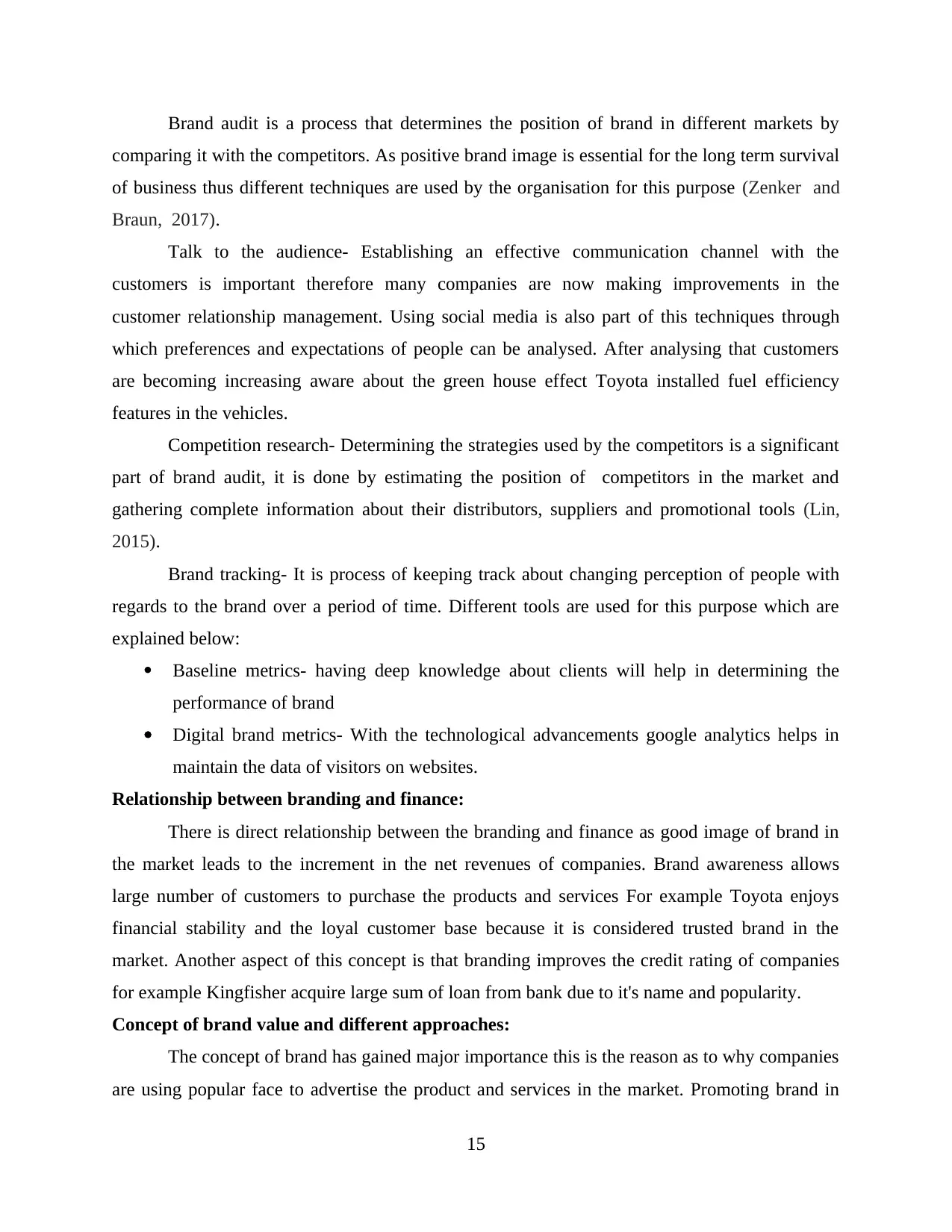
Brand audit is a process that determines the position of brand in different markets by
comparing it with the competitors. As positive brand image is essential for the long term survival
of business thus different techniques are used by the organisation for this purpose (Zenker and
Braun, 2017).
Talk to the audience- Establishing an effective communication channel with the
customers is important therefore many companies are now making improvements in the
customer relationship management. Using social media is also part of this techniques through
which preferences and expectations of people can be analysed. After analysing that customers
are becoming increasing aware about the green house effect Toyota installed fuel efficiency
features in the vehicles.
Competition research- Determining the strategies used by the competitors is a significant
part of brand audit, it is done by estimating the position of competitors in the market and
gathering complete information about their distributors, suppliers and promotional tools (Lin,
2015).
Brand tracking- It is process of keeping track about changing perception of people with
regards to the brand over a period of time. Different tools are used for this purpose which are
explained below:
Baseline metrics- having deep knowledge about clients will help in determining the
performance of brand
Digital brand metrics- With the technological advancements google analytics helps in
maintain the data of visitors on websites.
Relationship between branding and finance:
There is direct relationship between the branding and finance as good image of brand in
the market leads to the increment in the net revenues of companies. Brand awareness allows
large number of customers to purchase the products and services For example Toyota enjoys
financial stability and the loyal customer base because it is considered trusted brand in the
market. Another aspect of this concept is that branding improves the credit rating of companies
for example Kingfisher acquire large sum of loan from bank due to it's name and popularity.
Concept of brand value and different approaches:
The concept of brand has gained major importance this is the reason as to why companies
are using popular face to advertise the product and services in the market. Promoting brand in
15
comparing it with the competitors. As positive brand image is essential for the long term survival
of business thus different techniques are used by the organisation for this purpose (Zenker and
Braun, 2017).
Talk to the audience- Establishing an effective communication channel with the
customers is important therefore many companies are now making improvements in the
customer relationship management. Using social media is also part of this techniques through
which preferences and expectations of people can be analysed. After analysing that customers
are becoming increasing aware about the green house effect Toyota installed fuel efficiency
features in the vehicles.
Competition research- Determining the strategies used by the competitors is a significant
part of brand audit, it is done by estimating the position of competitors in the market and
gathering complete information about their distributors, suppliers and promotional tools (Lin,
2015).
Brand tracking- It is process of keeping track about changing perception of people with
regards to the brand over a period of time. Different tools are used for this purpose which are
explained below:
Baseline metrics- having deep knowledge about clients will help in determining the
performance of brand
Digital brand metrics- With the technological advancements google analytics helps in
maintain the data of visitors on websites.
Relationship between branding and finance:
There is direct relationship between the branding and finance as good image of brand in
the market leads to the increment in the net revenues of companies. Brand awareness allows
large number of customers to purchase the products and services For example Toyota enjoys
financial stability and the loyal customer base because it is considered trusted brand in the
market. Another aspect of this concept is that branding improves the credit rating of companies
for example Kingfisher acquire large sum of loan from bank due to it's name and popularity.
Concept of brand value and different approaches:
The concept of brand has gained major importance this is the reason as to why companies
are using popular face to advertise the product and services in the market. Promoting brand in
15
Paraphrase This Document
Need a fresh take? Get an instant paraphrase of this document with our AI Paraphraser
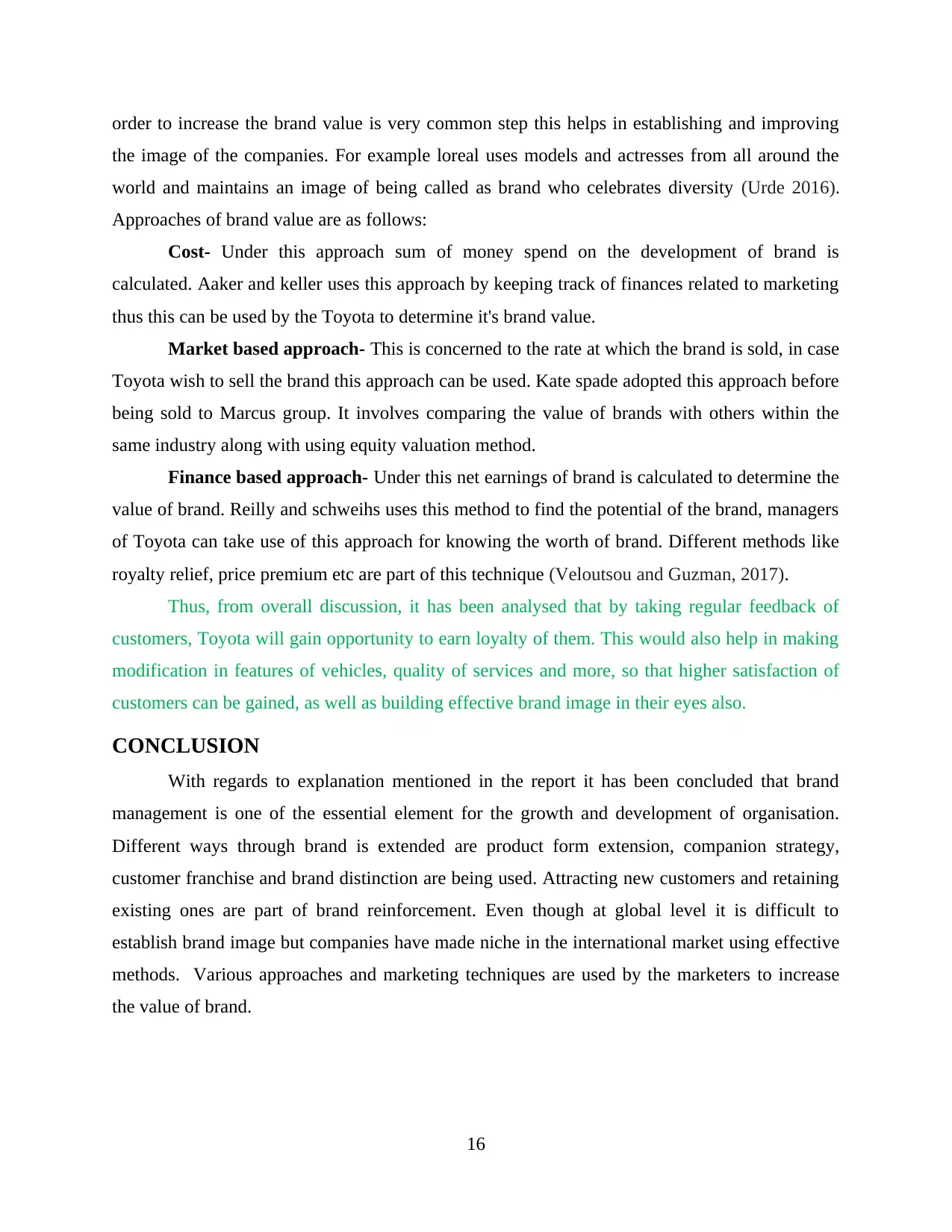
order to increase the brand value is very common step this helps in establishing and improving
the image of the companies. For example loreal uses models and actresses from all around the
world and maintains an image of being called as brand who celebrates diversity (Urde 2016).
Approaches of brand value are as follows:
Cost- Under this approach sum of money spend on the development of brand is
calculated. Aaker and keller uses this approach by keeping track of finances related to marketing
thus this can be used by the Toyota to determine it's brand value.
Market based approach- This is concerned to the rate at which the brand is sold, in case
Toyota wish to sell the brand this approach can be used. Kate spade adopted this approach before
being sold to Marcus group. It involves comparing the value of brands with others within the
same industry along with using equity valuation method.
Finance based approach- Under this net earnings of brand is calculated to determine the
value of brand. Reilly and schweihs uses this method to find the potential of the brand, managers
of Toyota can take use of this approach for knowing the worth of brand. Different methods like
royalty relief, price premium etc are part of this technique (Veloutsou and Guzman, 2017).
Thus, from overall discussion, it has been analysed that by taking regular feedback of
customers, Toyota will gain opportunity to earn loyalty of them. This would also help in making
modification in features of vehicles, quality of services and more, so that higher satisfaction of
customers can be gained, as well as building effective brand image in their eyes also.
CONCLUSION
With regards to explanation mentioned in the report it has been concluded that brand
management is one of the essential element for the growth and development of organisation.
Different ways through brand is extended are product form extension, companion strategy,
customer franchise and brand distinction are being used. Attracting new customers and retaining
existing ones are part of brand reinforcement. Even though at global level it is difficult to
establish brand image but companies have made niche in the international market using effective
methods. Various approaches and marketing techniques are used by the marketers to increase
the value of brand.
16
the image of the companies. For example loreal uses models and actresses from all around the
world and maintains an image of being called as brand who celebrates diversity (Urde 2016).
Approaches of brand value are as follows:
Cost- Under this approach sum of money spend on the development of brand is
calculated. Aaker and keller uses this approach by keeping track of finances related to marketing
thus this can be used by the Toyota to determine it's brand value.
Market based approach- This is concerned to the rate at which the brand is sold, in case
Toyota wish to sell the brand this approach can be used. Kate spade adopted this approach before
being sold to Marcus group. It involves comparing the value of brands with others within the
same industry along with using equity valuation method.
Finance based approach- Under this net earnings of brand is calculated to determine the
value of brand. Reilly and schweihs uses this method to find the potential of the brand, managers
of Toyota can take use of this approach for knowing the worth of brand. Different methods like
royalty relief, price premium etc are part of this technique (Veloutsou and Guzman, 2017).
Thus, from overall discussion, it has been analysed that by taking regular feedback of
customers, Toyota will gain opportunity to earn loyalty of them. This would also help in making
modification in features of vehicles, quality of services and more, so that higher satisfaction of
customers can be gained, as well as building effective brand image in their eyes also.
CONCLUSION
With regards to explanation mentioned in the report it has been concluded that brand
management is one of the essential element for the growth and development of organisation.
Different ways through brand is extended are product form extension, companion strategy,
customer franchise and brand distinction are being used. Attracting new customers and retaining
existing ones are part of brand reinforcement. Even though at global level it is difficult to
establish brand image but companies have made niche in the international market using effective
methods. Various approaches and marketing techniques are used by the marketers to increase
the value of brand.
16

1
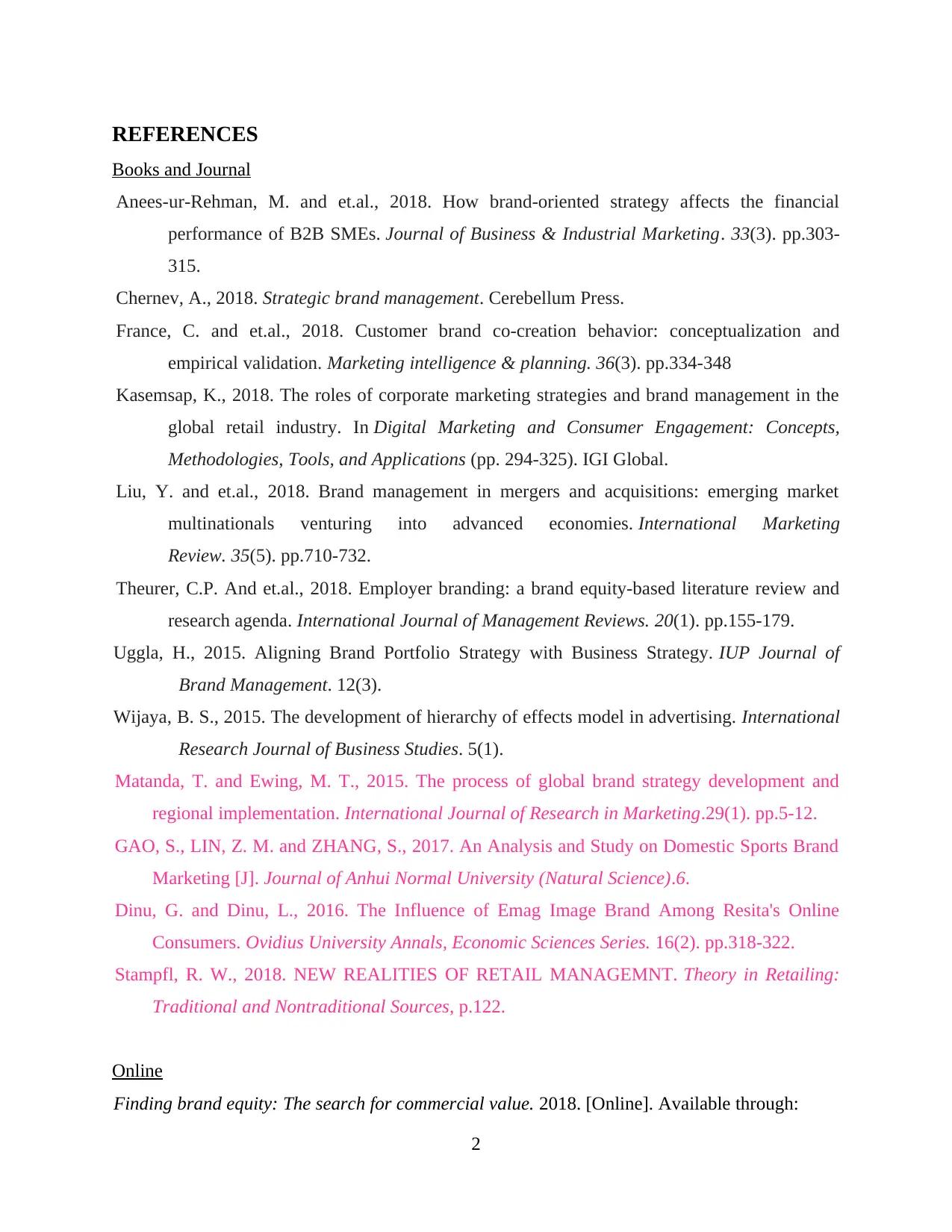
REFERENCES
Books and Journal
Anees-ur-Rehman, M. and et.al., 2018. How brand-oriented strategy affects the financial
performance of B2B SMEs. Journal of Business & Industrial Marketing. 33(3). pp.303-
315.
Chernev, A., 2018. Strategic brand management. Cerebellum Press.
France, C. and et.al., 2018. Customer brand co-creation behavior: conceptualization and
empirical validation. Marketing intelligence & planning. 36(3). pp.334-348
Kasemsap, K., 2018. The roles of corporate marketing strategies and brand management in the
global retail industry. In Digital Marketing and Consumer Engagement: Concepts,
Methodologies, Tools, and Applications (pp. 294-325). IGI Global.
Liu, Y. and et.al., 2018. Brand management in mergers and acquisitions: emerging market
multinationals venturing into advanced economies. International Marketing
Review. 35(5). pp.710-732.
Theurer, C.P. And et.al., 2018. Employer branding: a brand equity‐based literature review and
research agenda. International Journal of Management Reviews. 20(1). pp.155-179.
Uggla, H., 2015. Aligning Brand Portfolio Strategy with Business Strategy. IUP Journal of
Brand Management. 12(3).
Wijaya, B. S., 2015. The development of hierarchy of effects model in advertising. International
Research Journal of Business Studies. 5(1).
Matanda, T. and Ewing, M. T., 2015. The process of global brand strategy development and
regional implementation. International Journal of Research in Marketing.29(1). pp.5-12.
GAO, S., LIN, Z. M. and ZHANG, S., 2017. An Analysis and Study on Domestic Sports Brand
Marketing [J]. Journal of Anhui Normal University (Natural Science).6.
Dinu, G. and Dinu, L., 2016. The Influence of Emag Image Brand Among Resita's Online
Consumers. Ovidius University Annals, Economic Sciences Series. 16(2). pp.318-322.
Stampfl, R. W., 2018. NEW REALITIES OF RETAIL MANAGEMNT. Theory in Retailing:
Traditional and Nontraditional Sources, p.122.
Online
Finding brand equity: The search for commercial value. 2018. [Online]. Available through:
2
Books and Journal
Anees-ur-Rehman, M. and et.al., 2018. How brand-oriented strategy affects the financial
performance of B2B SMEs. Journal of Business & Industrial Marketing. 33(3). pp.303-
315.
Chernev, A., 2018. Strategic brand management. Cerebellum Press.
France, C. and et.al., 2018. Customer brand co-creation behavior: conceptualization and
empirical validation. Marketing intelligence & planning. 36(3). pp.334-348
Kasemsap, K., 2018. The roles of corporate marketing strategies and brand management in the
global retail industry. In Digital Marketing and Consumer Engagement: Concepts,
Methodologies, Tools, and Applications (pp. 294-325). IGI Global.
Liu, Y. and et.al., 2018. Brand management in mergers and acquisitions: emerging market
multinationals venturing into advanced economies. International Marketing
Review. 35(5). pp.710-732.
Theurer, C.P. And et.al., 2018. Employer branding: a brand equity‐based literature review and
research agenda. International Journal of Management Reviews. 20(1). pp.155-179.
Uggla, H., 2015. Aligning Brand Portfolio Strategy with Business Strategy. IUP Journal of
Brand Management. 12(3).
Wijaya, B. S., 2015. The development of hierarchy of effects model in advertising. International
Research Journal of Business Studies. 5(1).
Matanda, T. and Ewing, M. T., 2015. The process of global brand strategy development and
regional implementation. International Journal of Research in Marketing.29(1). pp.5-12.
GAO, S., LIN, Z. M. and ZHANG, S., 2017. An Analysis and Study on Domestic Sports Brand
Marketing [J]. Journal of Anhui Normal University (Natural Science).6.
Dinu, G. and Dinu, L., 2016. The Influence of Emag Image Brand Among Resita's Online
Consumers. Ovidius University Annals, Economic Sciences Series. 16(2). pp.318-322.
Stampfl, R. W., 2018. NEW REALITIES OF RETAIL MANAGEMNT. Theory in Retailing:
Traditional and Nontraditional Sources, p.122.
Online
Finding brand equity: The search for commercial value. 2018. [Online]. Available through:
2
Secure Best Marks with AI Grader
Need help grading? Try our AI Grader for instant feedback on your assignments.

3
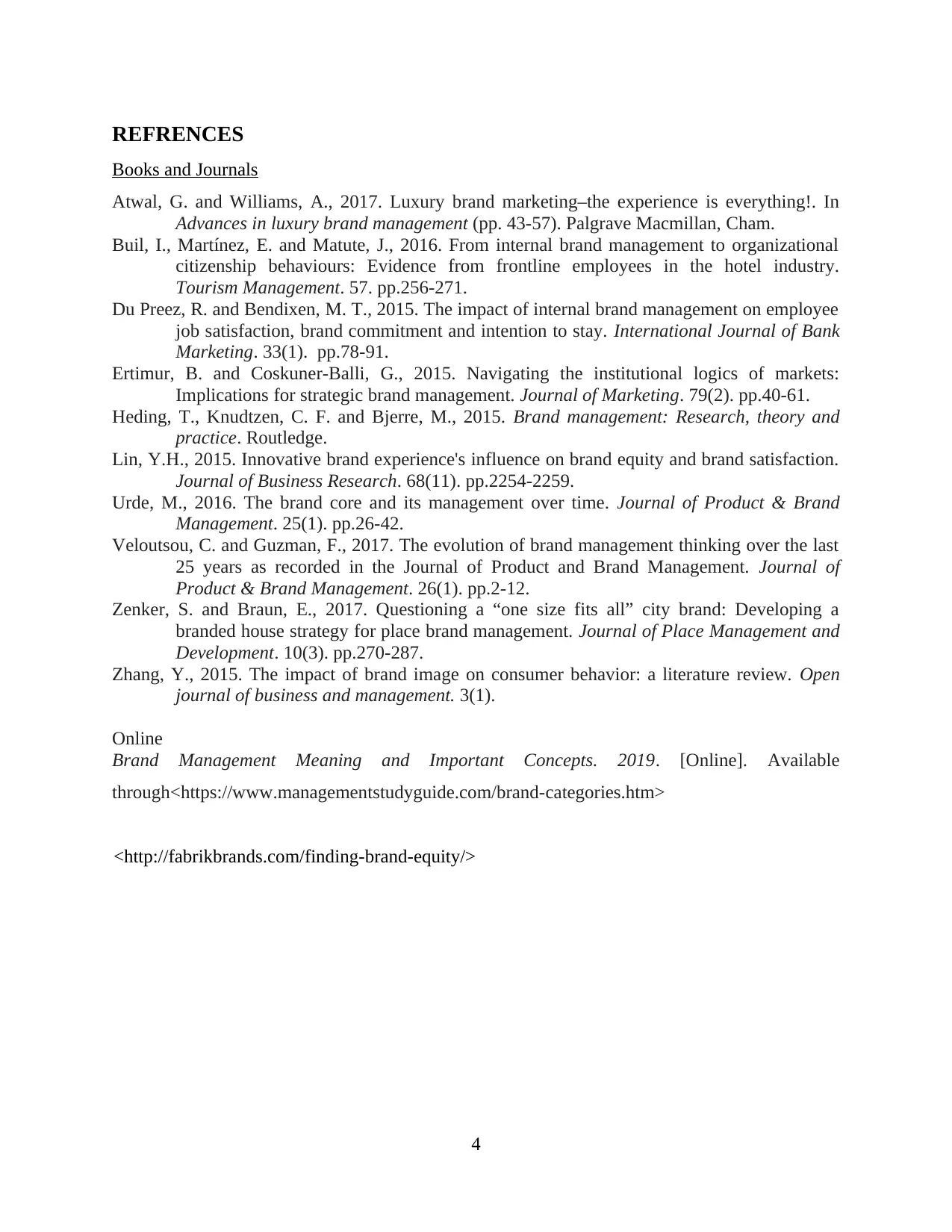
REFRENCES
Books and Journals
Atwal, G. and Williams, A., 2017. Luxury brand marketing–the experience is everything!. In
Advances in luxury brand management (pp. 43-57). Palgrave Macmillan, Cham.
Buil, I., Martínez, E. and Matute, J., 2016. From internal brand management to organizational
citizenship behaviours: Evidence from frontline employees in the hotel industry.
Tourism Management. 57. pp.256-271.
Du Preez, R. and Bendixen, M. T., 2015. The impact of internal brand management on employee
job satisfaction, brand commitment and intention to stay. International Journal of Bank
Marketing. 33(1). pp.78-91.
Ertimur, B. and Coskuner-Balli, G., 2015. Navigating the institutional logics of markets:
Implications for strategic brand management. Journal of Marketing. 79(2). pp.40-61.
Heding, T., Knudtzen, C. F. and Bjerre, M., 2015. Brand management: Research, theory and
practice. Routledge.
Lin, Y.H., 2015. Innovative brand experience's influence on brand equity and brand satisfaction.
Journal of Business Research. 68(11). pp.2254-2259.
Urde, M., 2016. The brand core and its management over time. Journal of Product & Brand
Management. 25(1). pp.26-42.
Veloutsou, C. and Guzman, F., 2017. The evolution of brand management thinking over the last
25 years as recorded in the Journal of Product and Brand Management. Journal of
Product & Brand Management. 26(1). pp.2-12.
Zenker, S. and Braun, E., 2017. Questioning a “one size fits all” city brand: Developing a
branded house strategy for place brand management. Journal of Place Management and
Development. 10(3). pp.270-287.
Zhang, Y., 2015. The impact of brand image on consumer behavior: a literature review. Open
journal of business and management. 3(1).
Online
Brand Management Meaning and Important Concepts. 2019. [Online]. Available
through<https://www.managementstudyguide.com/brand-categories.htm>
<http://fabrikbrands.com/finding-brand-equity/>
4
Books and Journals
Atwal, G. and Williams, A., 2017. Luxury brand marketing–the experience is everything!. In
Advances in luxury brand management (pp. 43-57). Palgrave Macmillan, Cham.
Buil, I., Martínez, E. and Matute, J., 2016. From internal brand management to organizational
citizenship behaviours: Evidence from frontline employees in the hotel industry.
Tourism Management. 57. pp.256-271.
Du Preez, R. and Bendixen, M. T., 2015. The impact of internal brand management on employee
job satisfaction, brand commitment and intention to stay. International Journal of Bank
Marketing. 33(1). pp.78-91.
Ertimur, B. and Coskuner-Balli, G., 2015. Navigating the institutional logics of markets:
Implications for strategic brand management. Journal of Marketing. 79(2). pp.40-61.
Heding, T., Knudtzen, C. F. and Bjerre, M., 2015. Brand management: Research, theory and
practice. Routledge.
Lin, Y.H., 2015. Innovative brand experience's influence on brand equity and brand satisfaction.
Journal of Business Research. 68(11). pp.2254-2259.
Urde, M., 2016. The brand core and its management over time. Journal of Product & Brand
Management. 25(1). pp.26-42.
Veloutsou, C. and Guzman, F., 2017. The evolution of brand management thinking over the last
25 years as recorded in the Journal of Product and Brand Management. Journal of
Product & Brand Management. 26(1). pp.2-12.
Zenker, S. and Braun, E., 2017. Questioning a “one size fits all” city brand: Developing a
branded house strategy for place brand management. Journal of Place Management and
Development. 10(3). pp.270-287.
Zhang, Y., 2015. The impact of brand image on consumer behavior: a literature review. Open
journal of business and management. 3(1).
Online
Brand Management Meaning and Important Concepts. 2019. [Online]. Available
through<https://www.managementstudyguide.com/brand-categories.htm>
<http://fabrikbrands.com/finding-brand-equity/>
4
1 out of 24
Related Documents
Your All-in-One AI-Powered Toolkit for Academic Success.
+13062052269
info@desklib.com
Available 24*7 on WhatsApp / Email
![[object Object]](/_next/static/media/star-bottom.7253800d.svg)
Unlock your academic potential
© 2024 | Zucol Services PVT LTD | All rights reserved.





